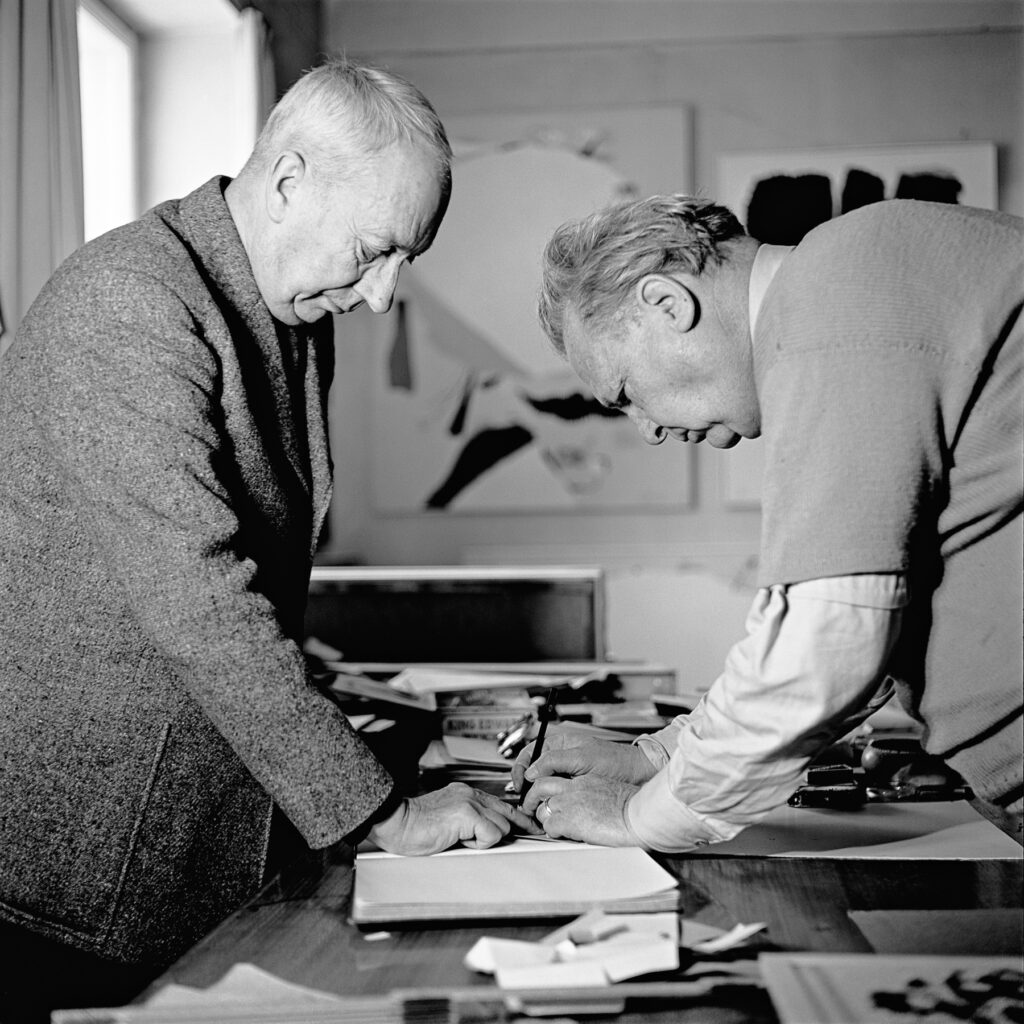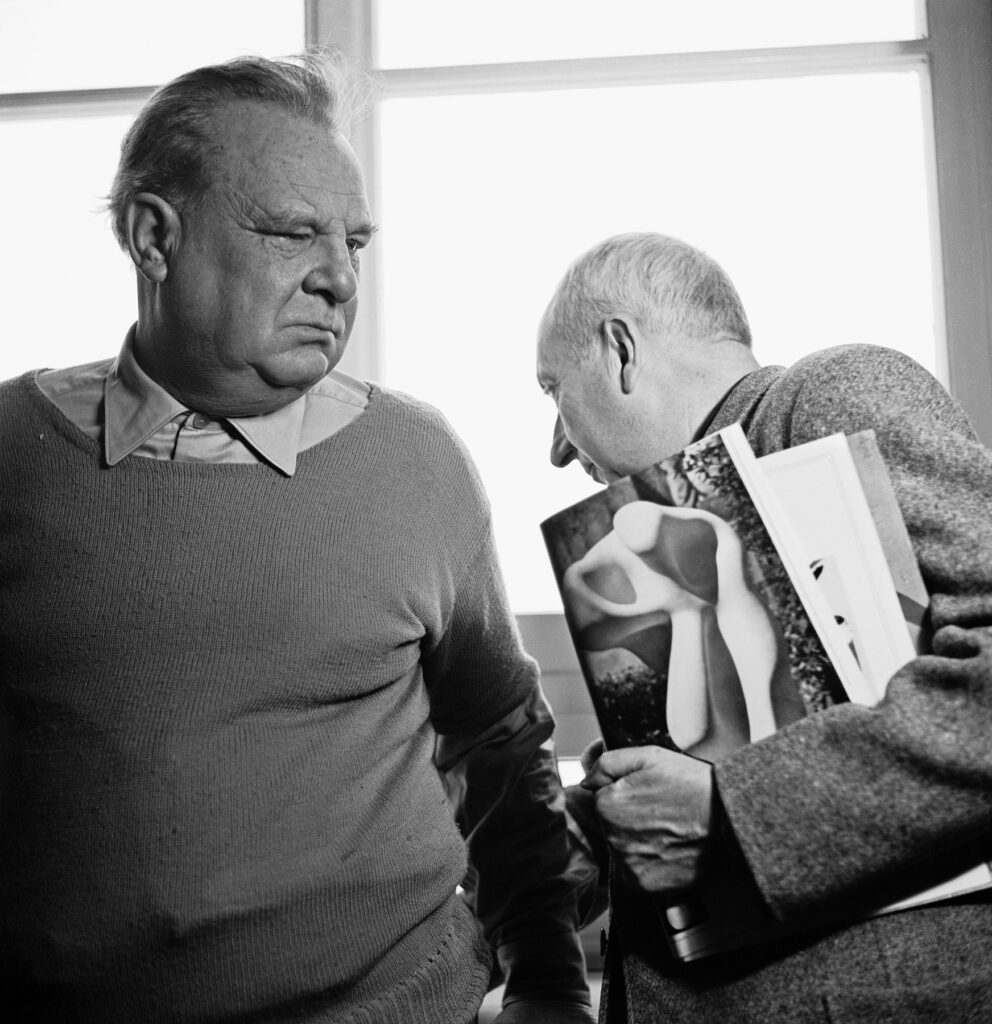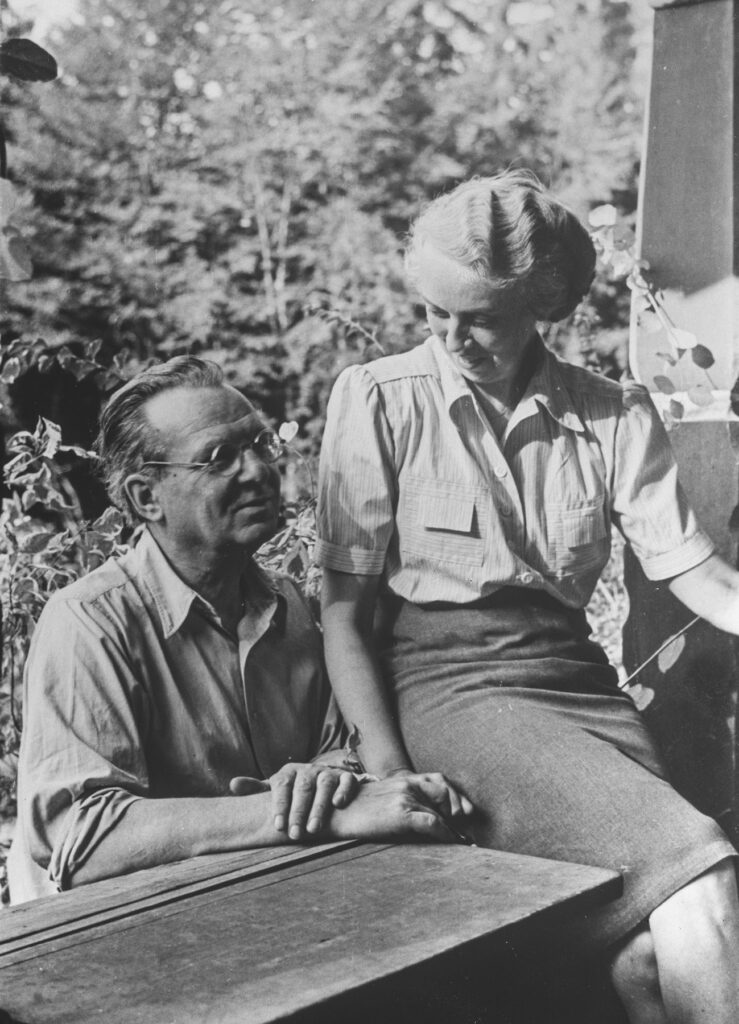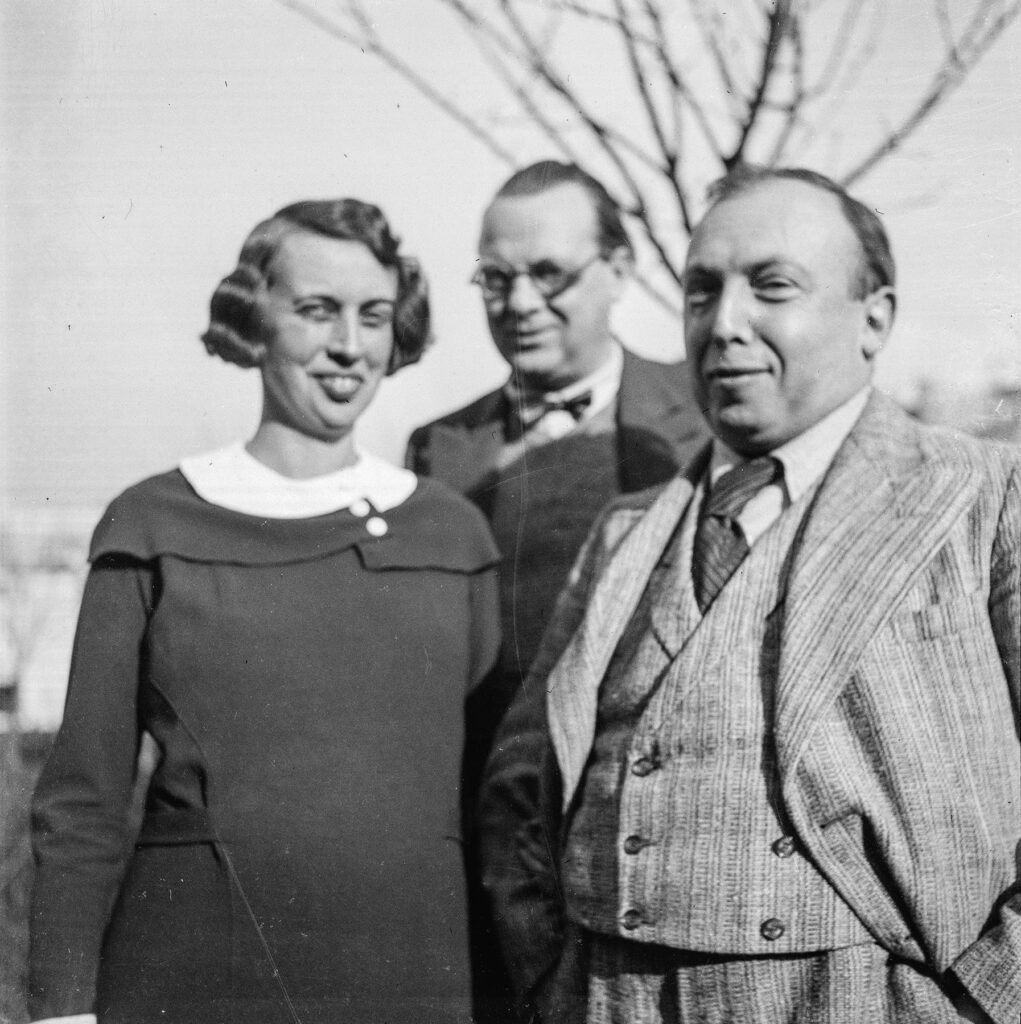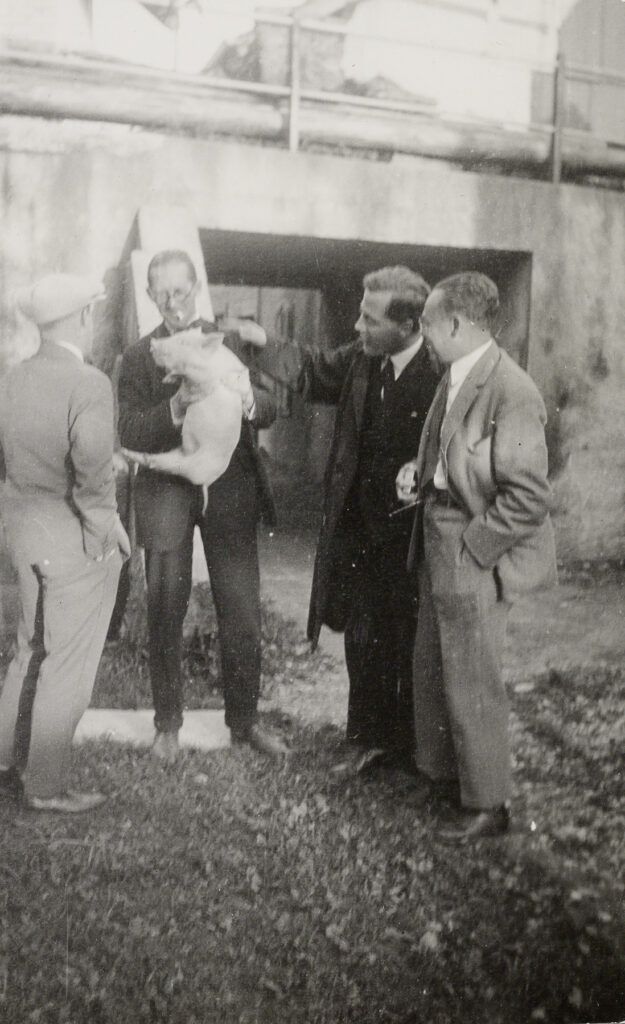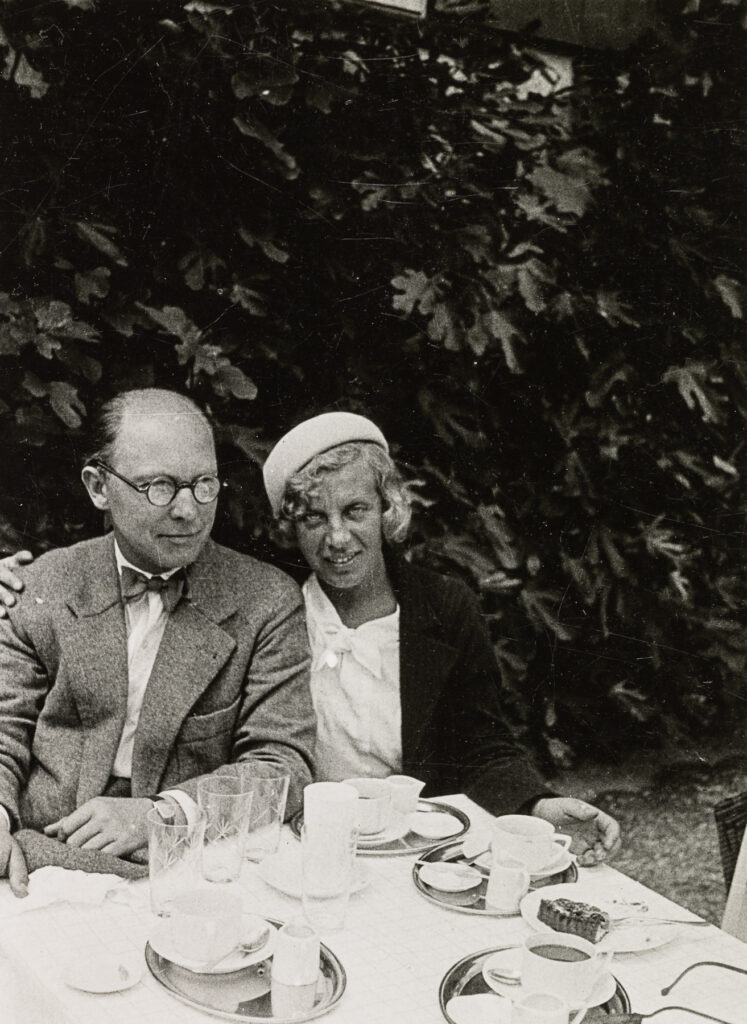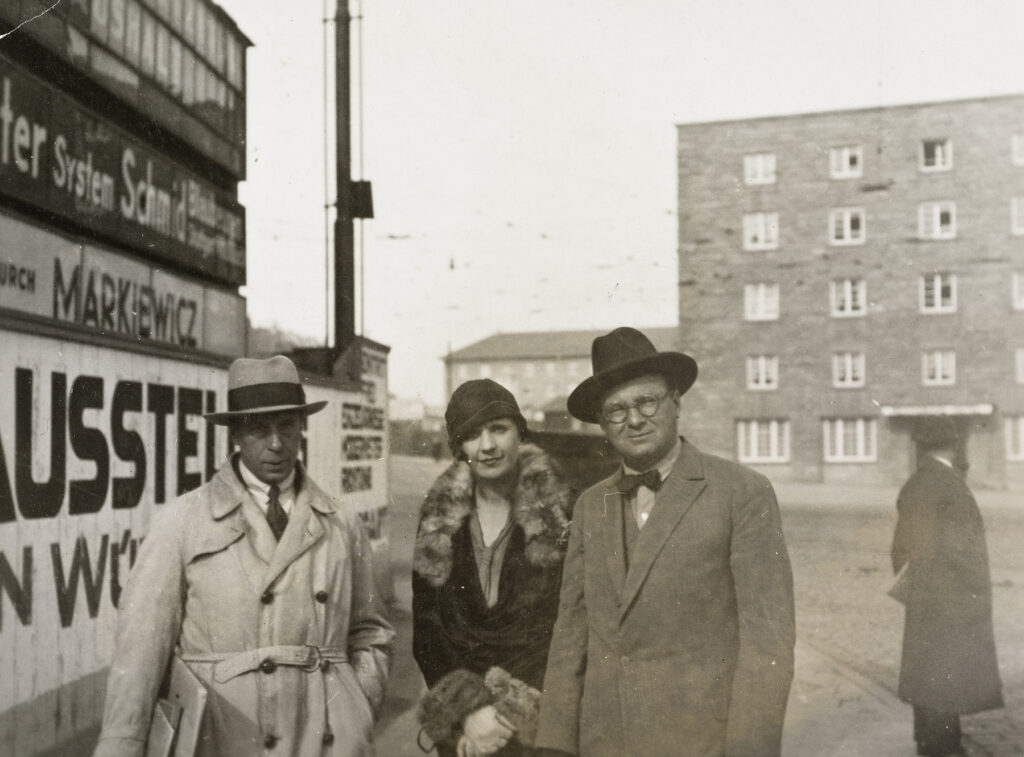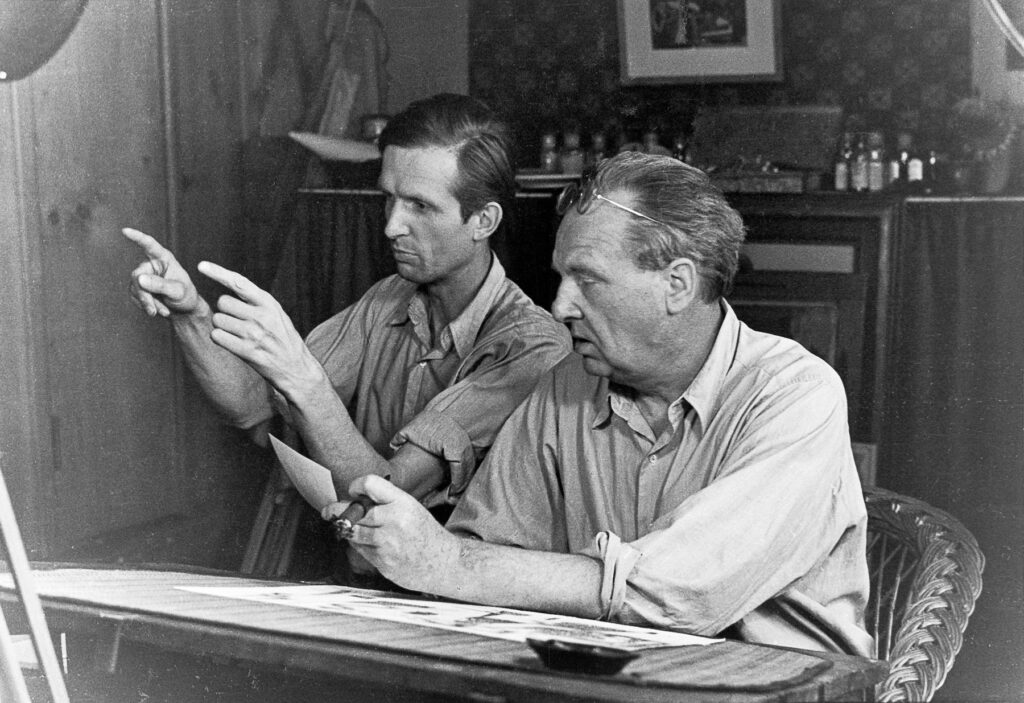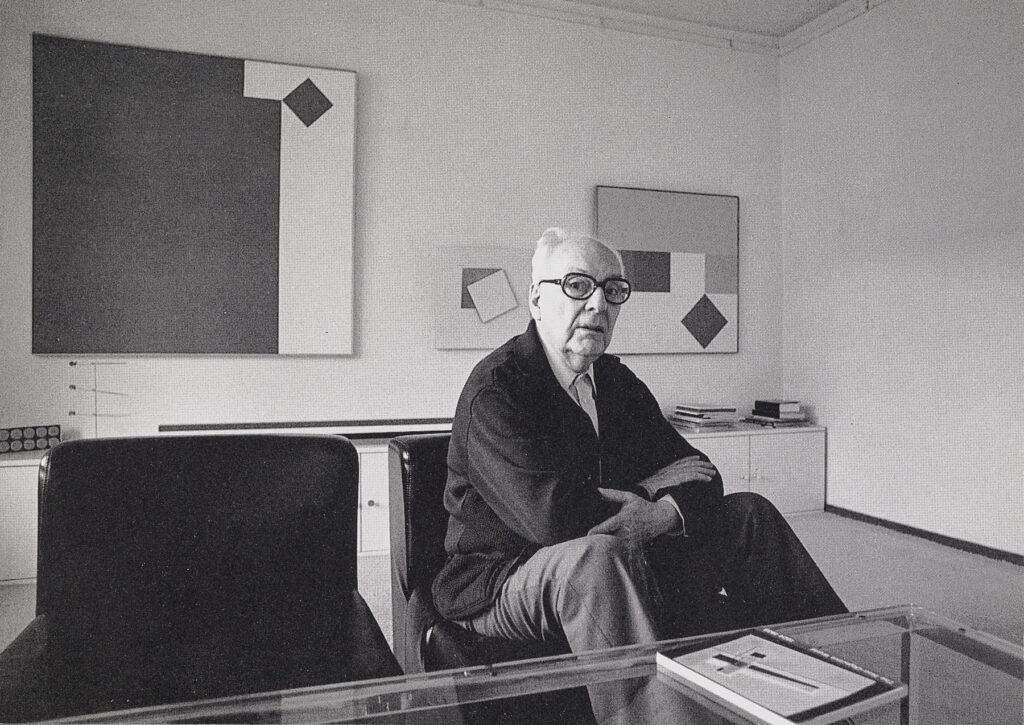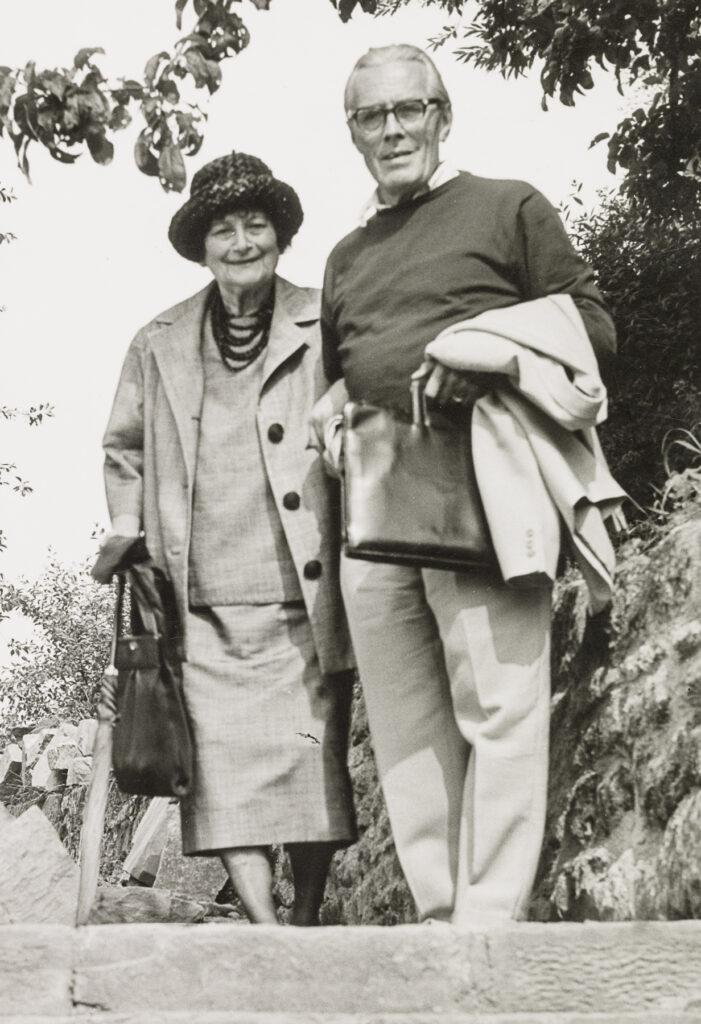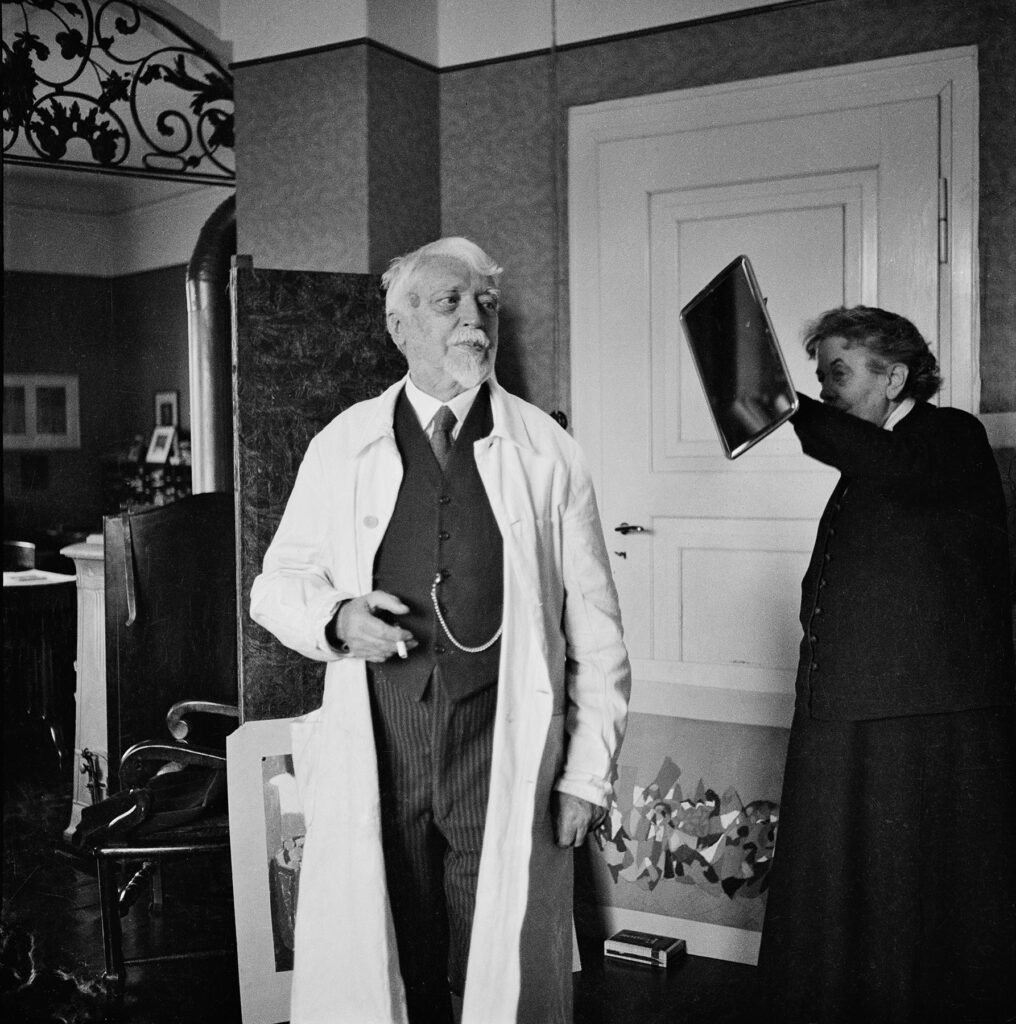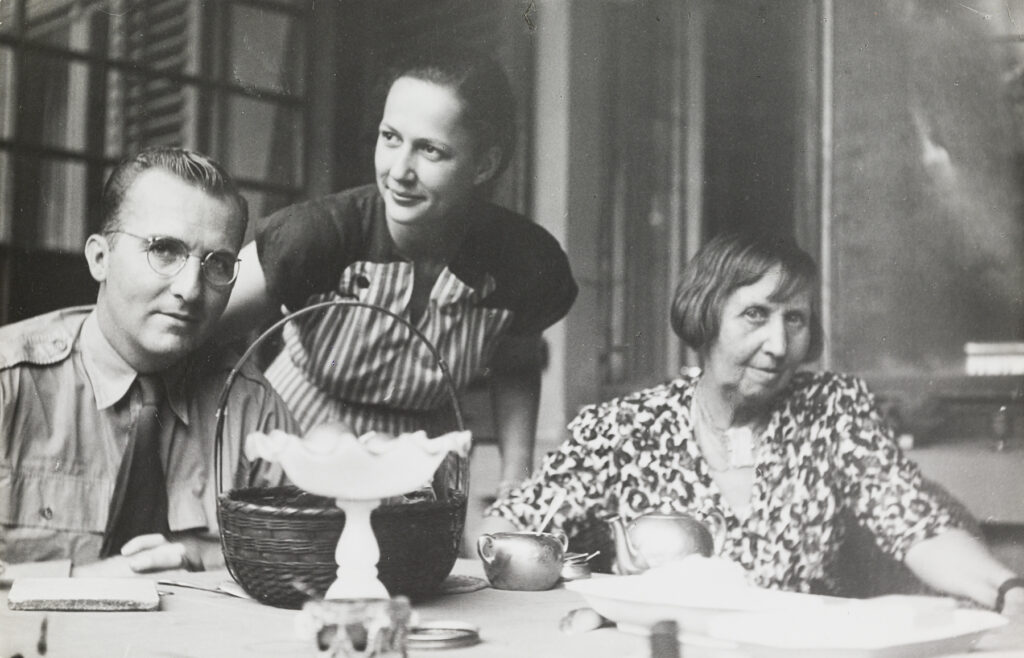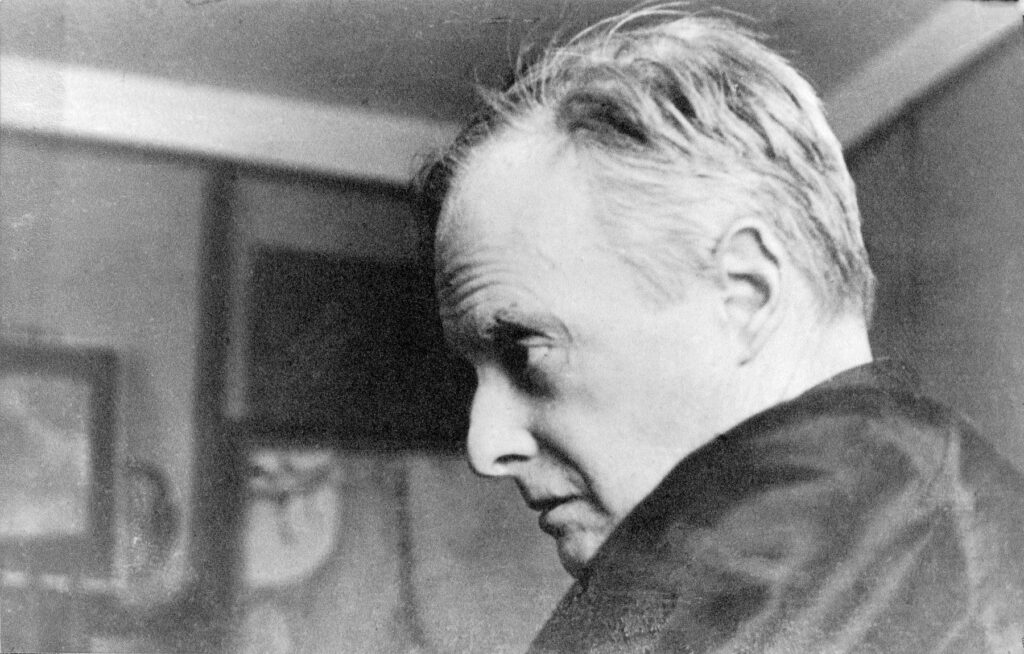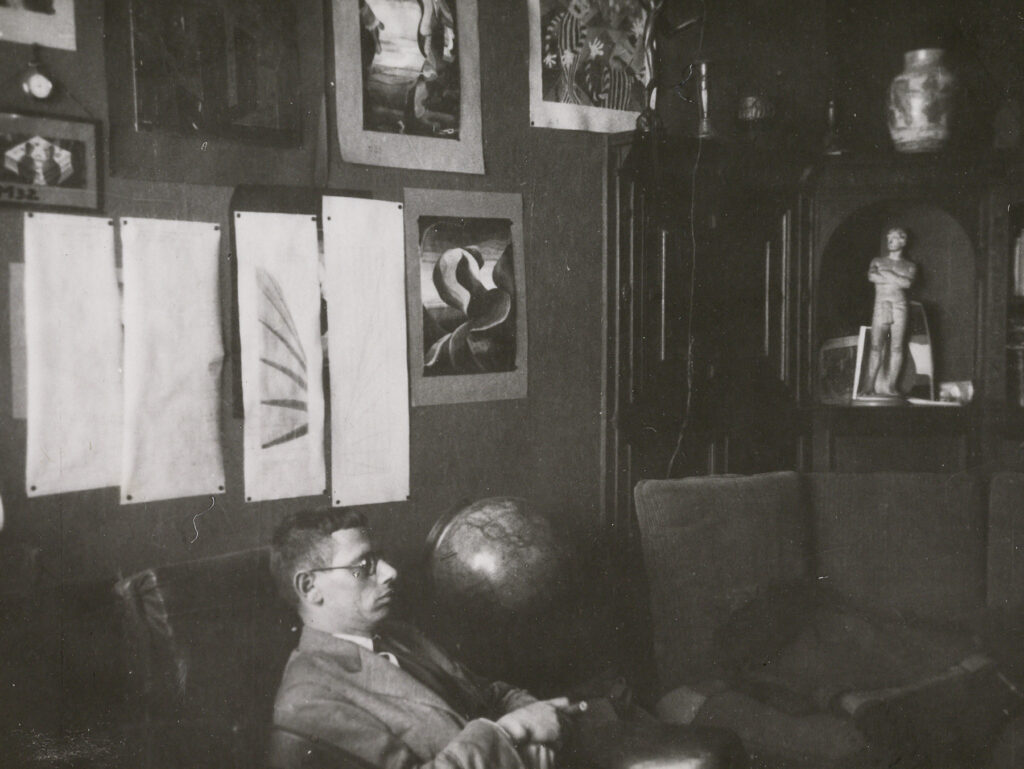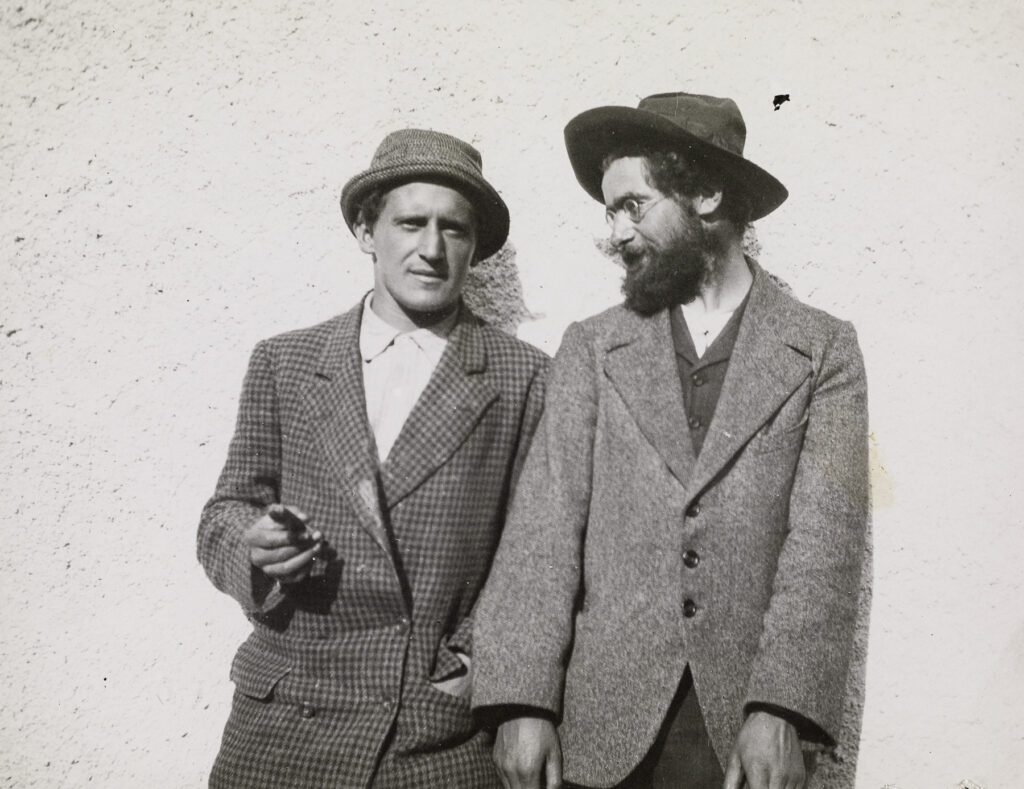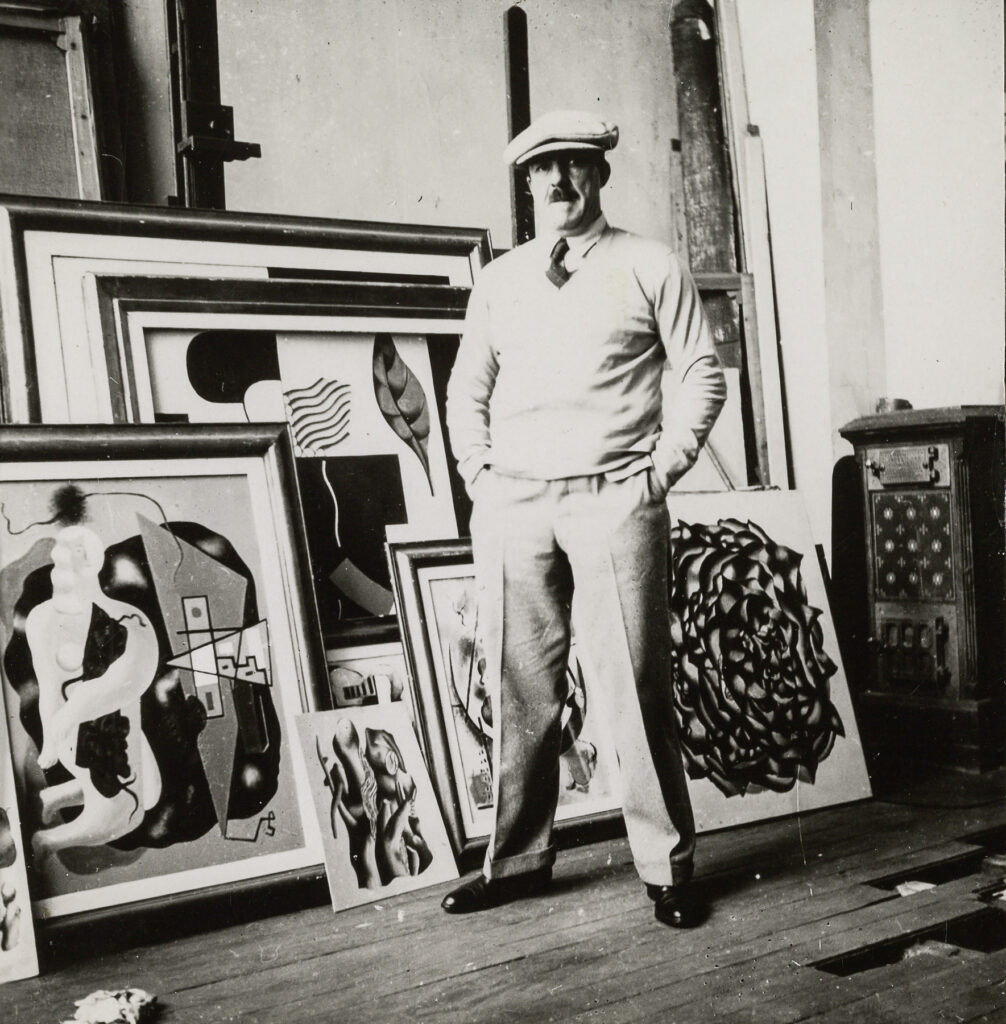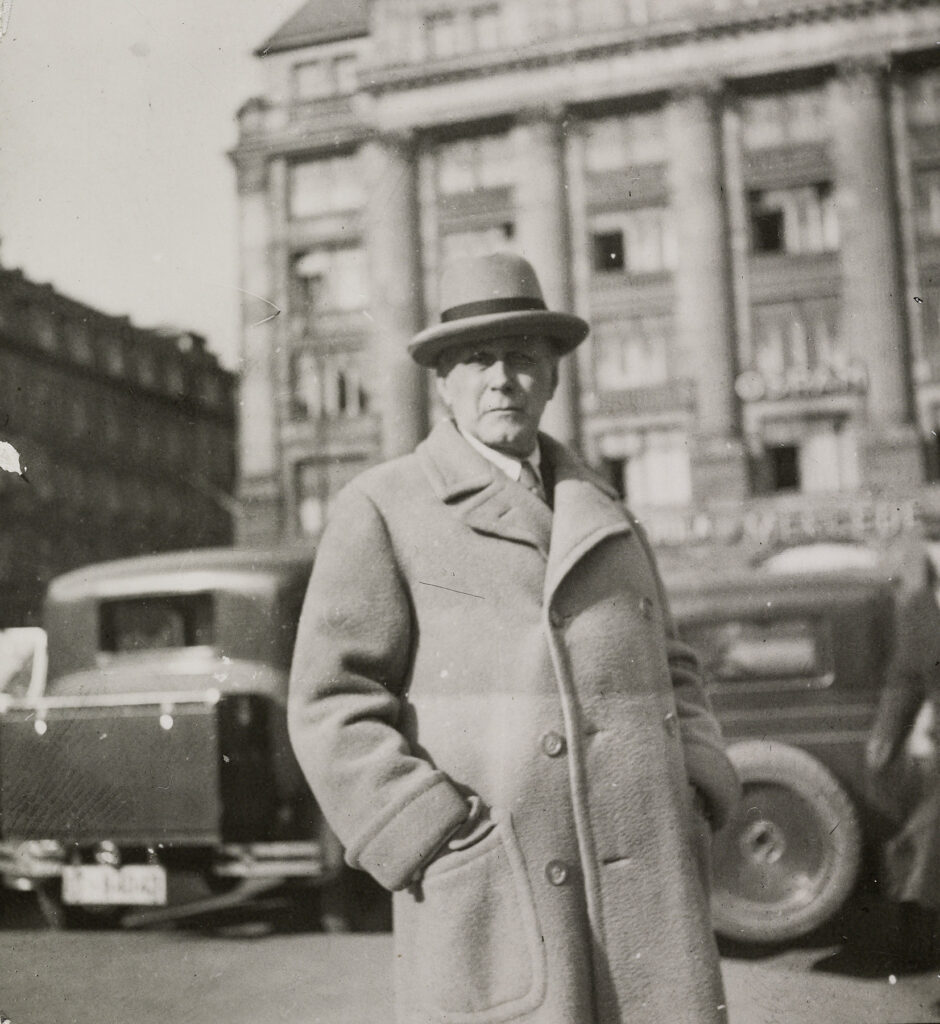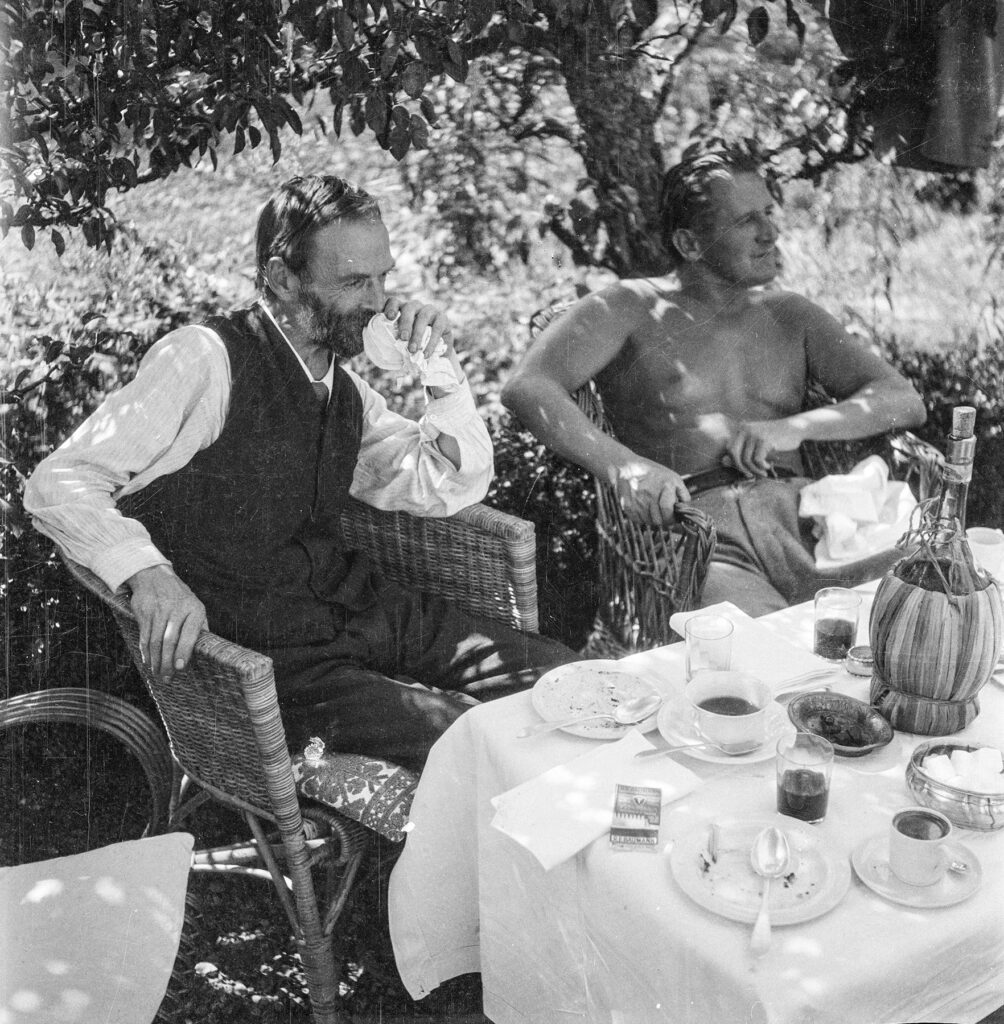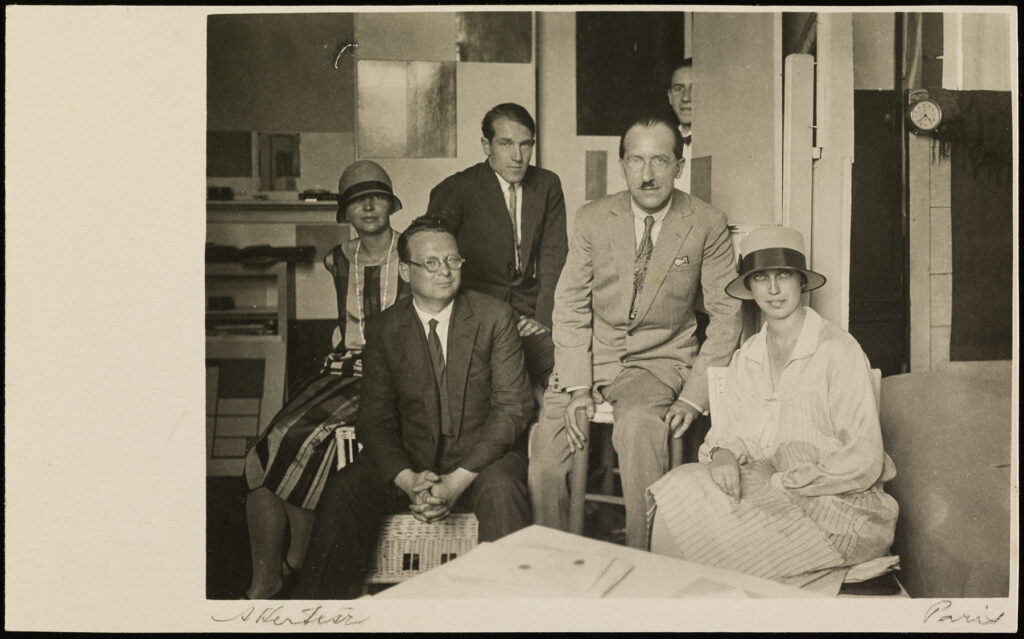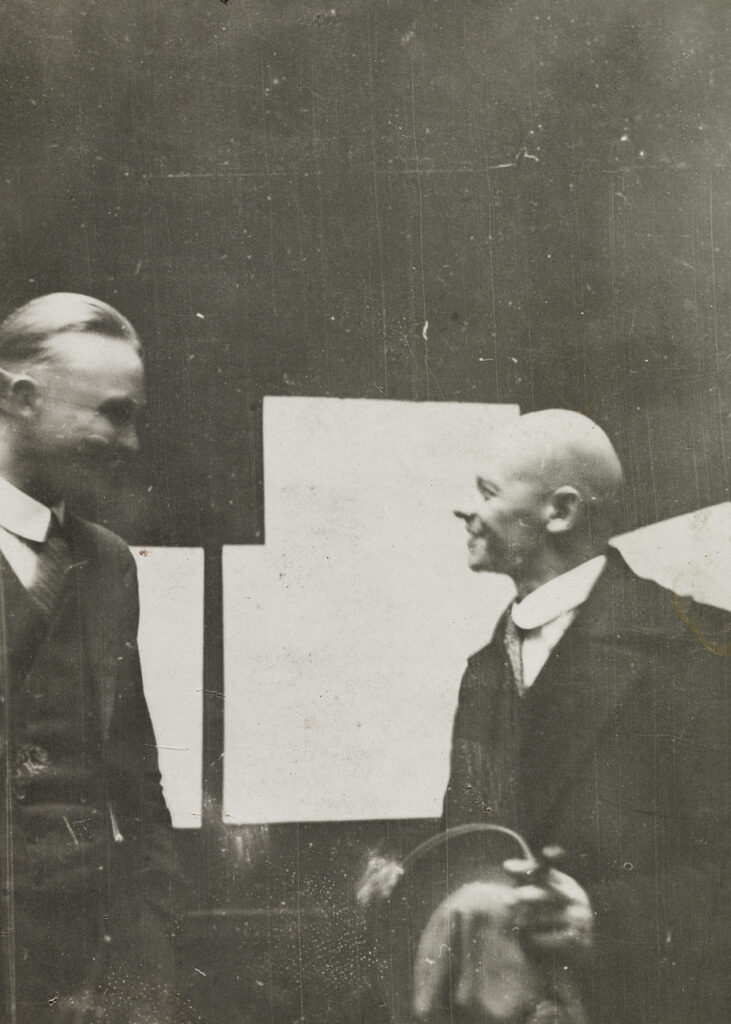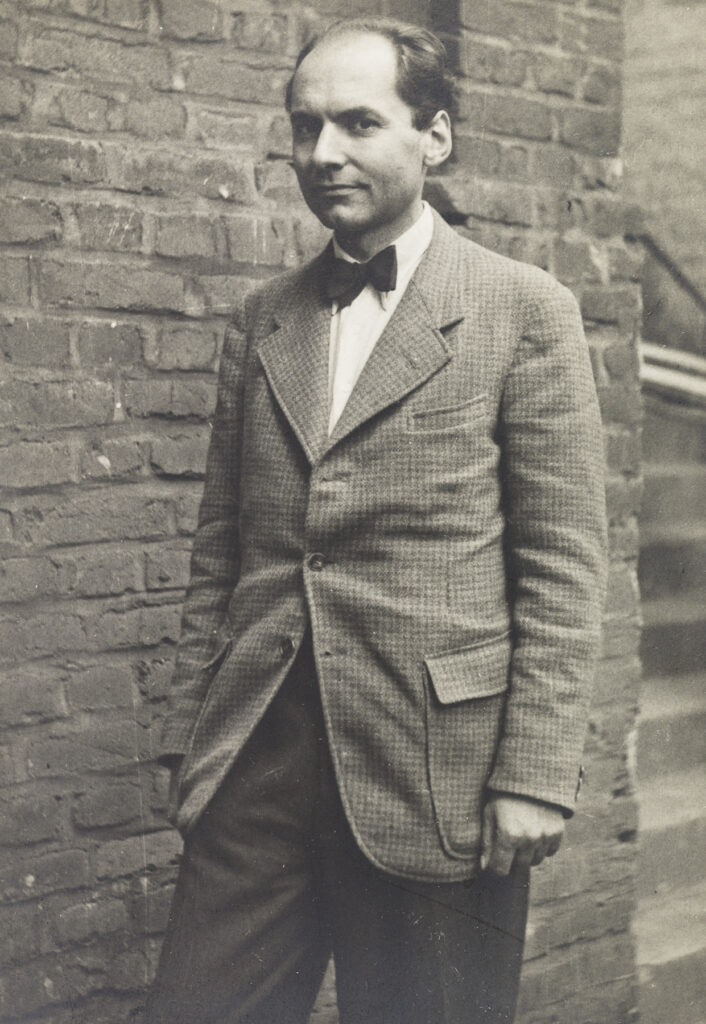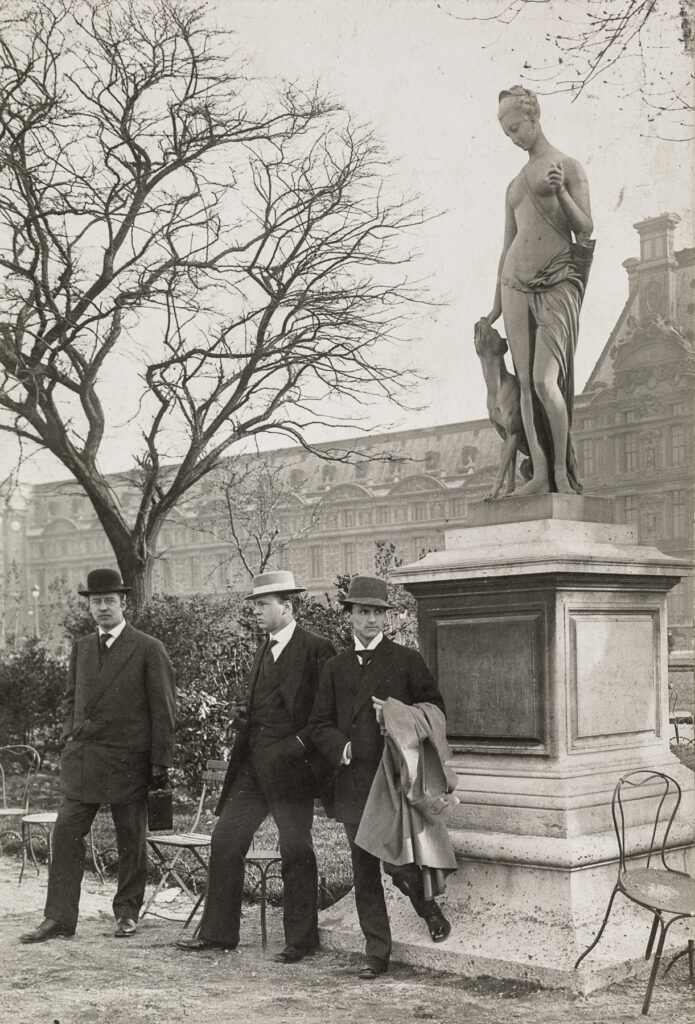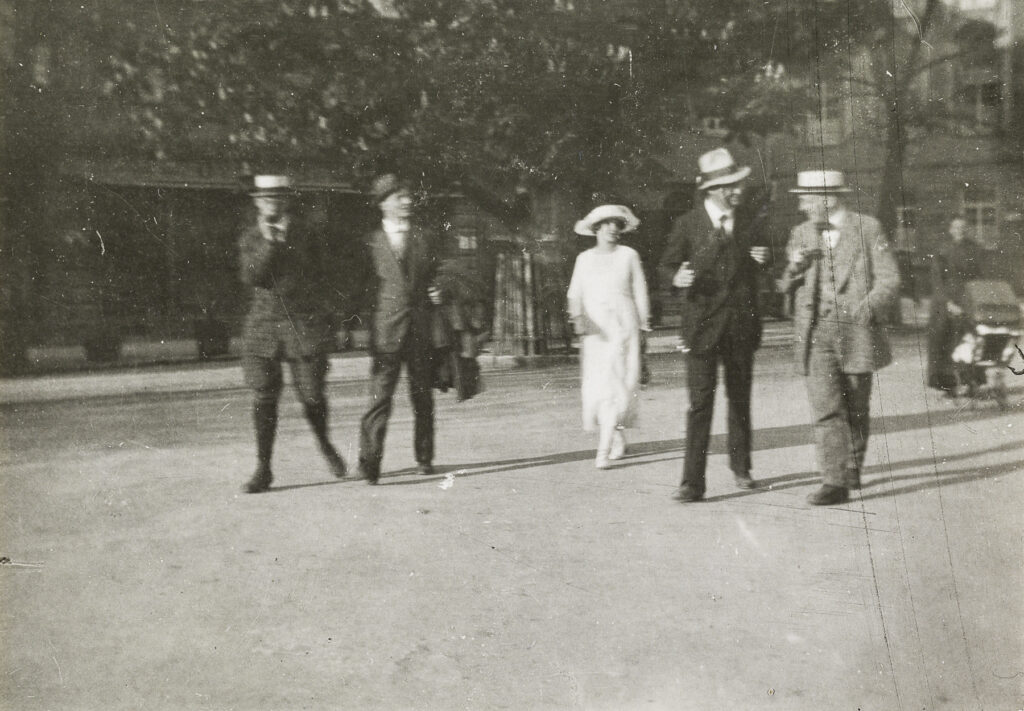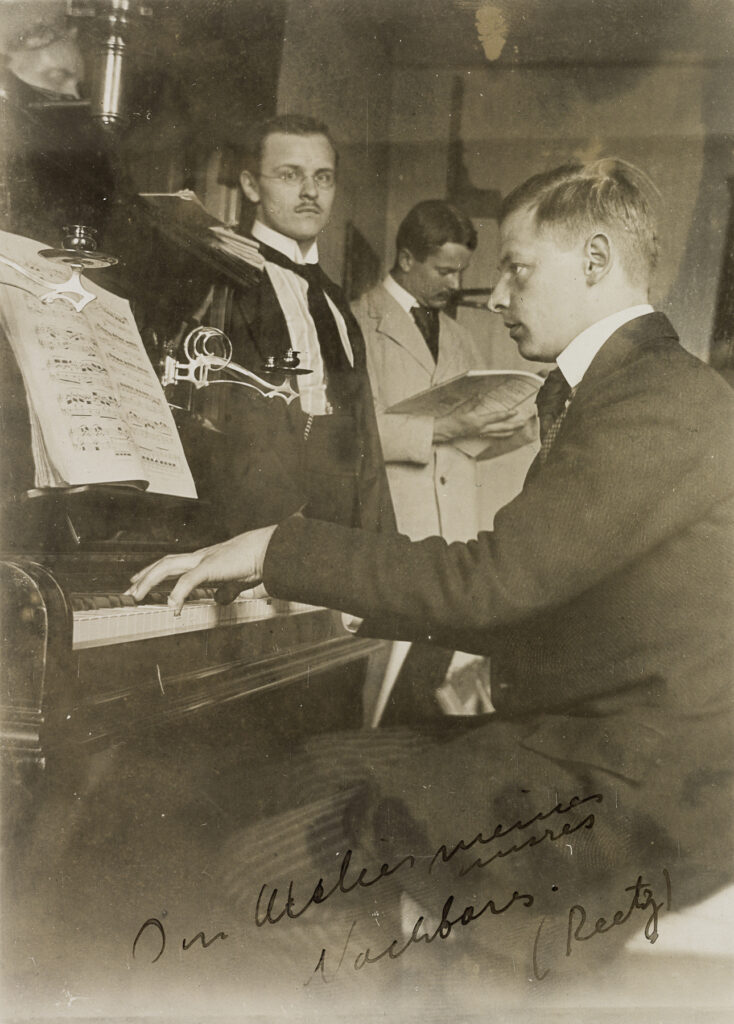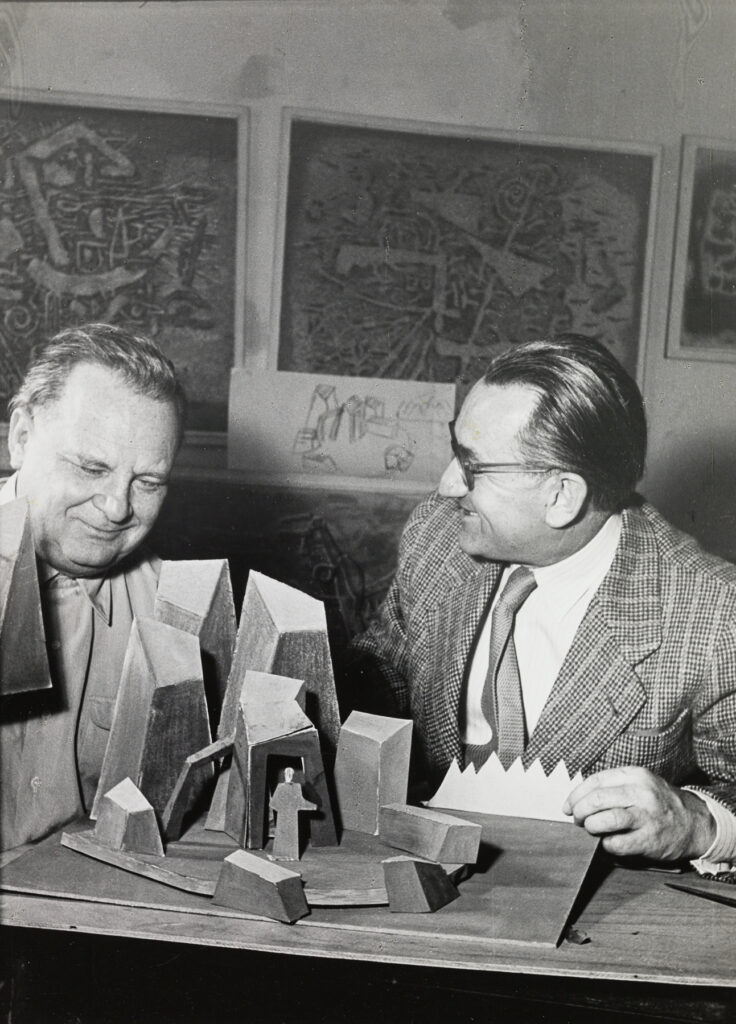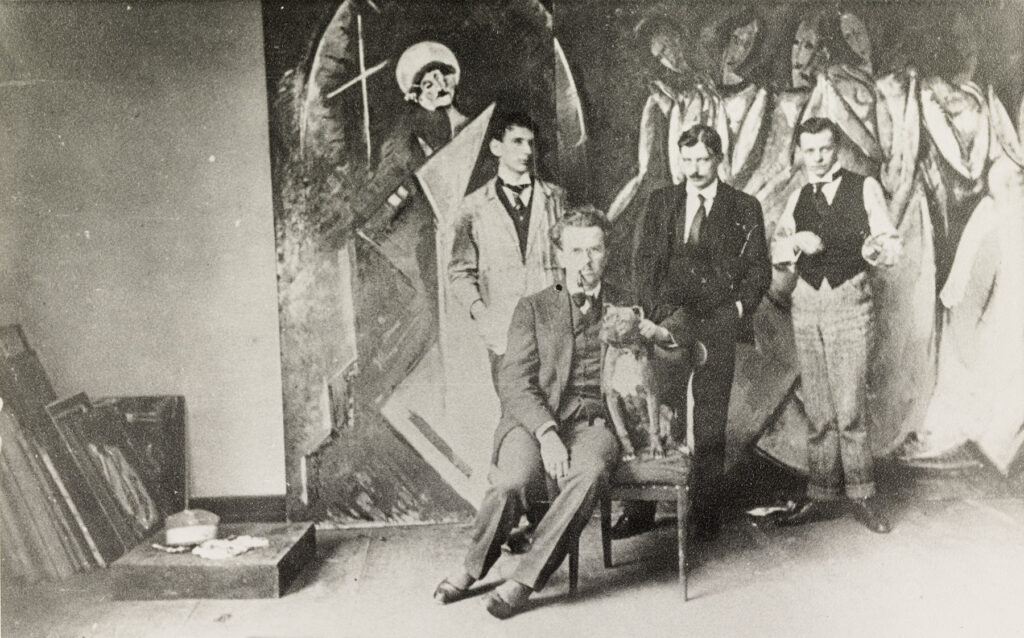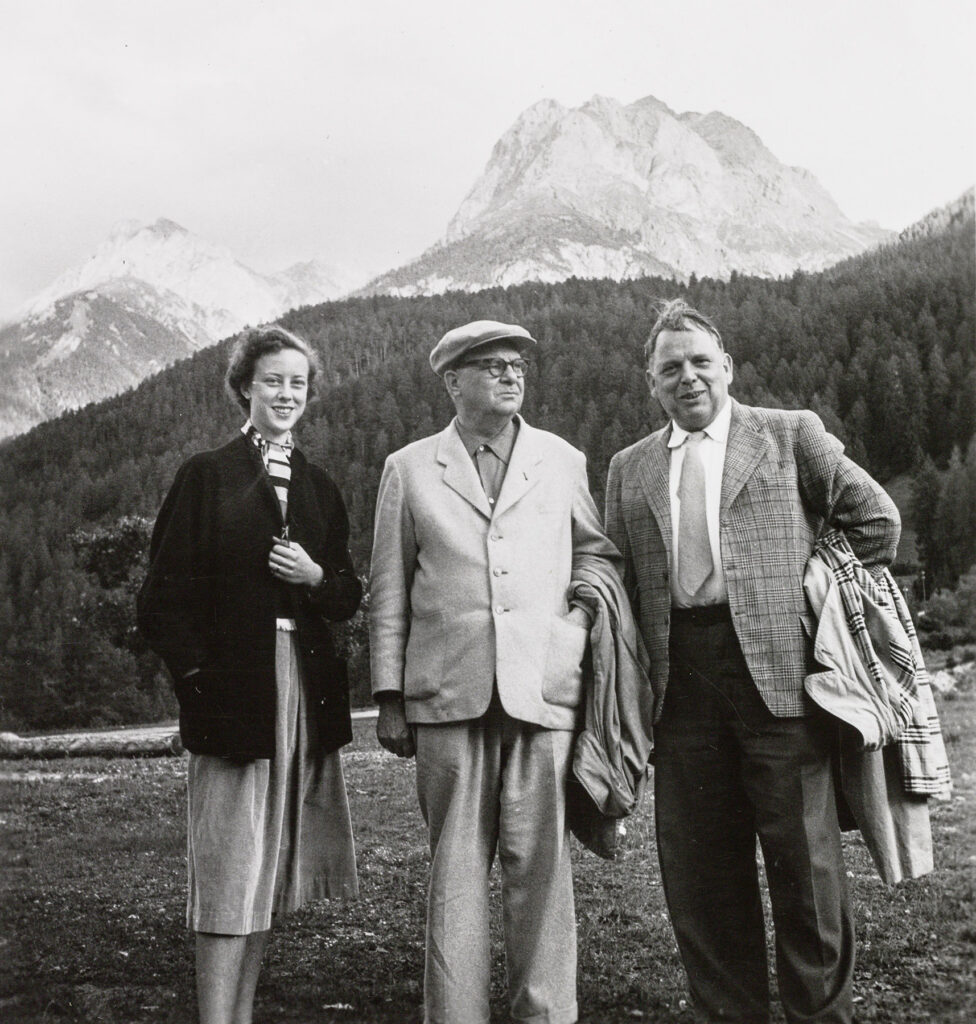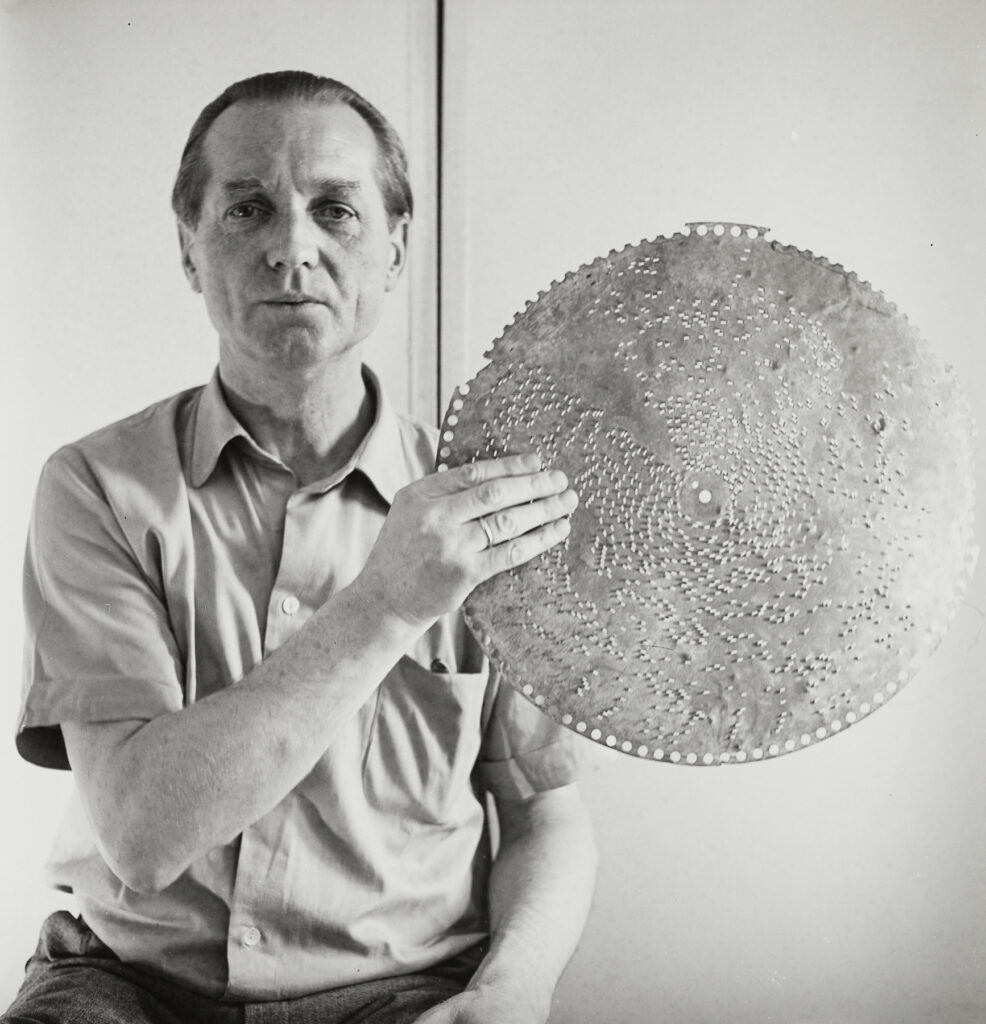Briefly presented here on a continual basis will be all those painters, graphic artists, sculptors, and architects with whom Willi Baumeister was befriended, with whom he collaborated, who influenced him, or in some other way crossed his path as an artist.
A–G
Max Ackermann
The painter and graphic artist Max Ackermann (1887 to 1975) counts among the most important artists of abstraction in Germany. In 1911 he began studying at the Academy in Stuttgart, beginning in 1912 with Adolf Hölzel, where he met Baumeister. In 1945 he took Baumeister’s family into his home in Horn near Radolfzell.
Link: Max Ackermann-Archiv
Hans Arp
Baumeister first made contact with the German painter, sculptor, and poet Hans Arp (1887 to 1966) through Kurt Schwitters. The friendship probably began in the 1920s in Paris. A 1930 meeting in Paris is documented. In 1938 Arp saw Baumeister’s works of art that in 1937–38 were stored in the Kunsthalle Basel for protection from the National Socialists. In 1939 he visited Baumeister’s opening at the Gallery Jeanne Bucher in Paris with Kandinsky. Between 1948 and 1955 they made various mutual studio visits and exchanged works of art that in each case were donated to a museum after their deaths.
Links: Arp Museum Bahnhof Rolandseck | Arp biography on Wikipedia
Margarete/Margrit Baumeister
Willi Baumeister’s wife – see under Collectors, Supporters, Friends I Margarete Oehm
Ella Bergmann-Michel
The German artist Ella Bergmann-Michel (1895–1971) studied art in Weimar from 1915, where she met Robert Michel at the Academy of Fine Arts. Walter Gropius exhibited her collages during the opening of the Weimar Bauhaus in 1919. In 1919, she married Robert Michel. In 1920, the couple moved to the Taunus region, where they converted a paint mill into studios. A circle of artists formed around Willi Baumeister, László Moholy-Nagy, Jan Tschichold, and Kurt Schwitters. From 1923 onwards, Ella Bergmann-Michel worked with constructivist collages and exhibited several times together with Robert Michel. In 1925, she exhibited in Wiesbaden with El Lissitzky and Kurt Schwitters; in 1927, she exhibited at the Werkbund exhibition in Stuttgart; in 1928, she participated in the traveling exhibition of the “Société Anonyme” in the USA; and in 1929, she exhibited at “Abstract and Surrealist Painting and Sculpture” in Frankfurt and Zurich. In 1933, she was banned from exhibiting by the Reich Chamber of Culture. After 1945, she headed the Frankfurt Film Club and became involved in experimental film.
Max Bill
The Swiss architect, artist, and designer Max Bill (1908 to 1994) is one of the most important artists of concrete art. In 1927–28 he studied in Dessau at the Bauhaus. He taught at the College for Design in Ulm/Donau. Bill and Baumeister were linked by collegiality and friendship. During visits they exchanged works and discovered their mutual interest in archeology, particularly in Cycladic idols. At the end of 1946, Bill planned an exhibition in Zurich with Baumeister and Schlemmer. On Baumeister’s initiative, Max Bill sent to Milan some of the pictures that Baumeister had sent to the Kunsthalle Basel in 1937–38 for protection from the National Socialists. After the end of war they began a lively correspondence that contained mutual a
Links: Max-Bill-Foundations | Bill’s biography on Wikipedia
Julius Bissier
German painter (1893 to 1965). First influenced by the new objectivity (Neue Sachlichkeit) and surrealism, later a representative of nonrepresentational art. Beginning in 1929 friendship with Baumeister. Like him, Bissier was inspired for a time by Far Eastern influences.
Links: www.bissier.org | Bissier biography at Ketterer
Rolf Cavael
The German painter, draftsman, and graphic artist Rolf Cavael (1898 to 1979) was an important representative of nonrepresentational painting in Germany. He studied at the Frankfurt Städelschule, and beginning in 1926 taught in the field of applied graphics at the business school there. During that time he met Baumeister. In 1949 he was – like Baumeister – a co-founder of the group “ZEN 49”.
Link: Cavael biography on Wikipedia
Le Corbusier
Actually Charles Edouard Jeanneret (1887 to 1965) was a French-Swiss architect, architectural theorist, city planner, painter, and sculptor. Beginning in 1917 he lived in Paris, where in 1921 he became aware of Baumeister through a German art journal. In 1922 an article on Baumeister appeared in the journal published by Le Corbusier and Amédée Ozenfant, ‘L’Esprit Nouveau’. The first personal meeting with Baumeister took place in 1924 in Paris. In 1927 they collaborated closely in connection with the Stuttgart Weissenhof Housing Settlement, which led to a lifelong friendship and lively exchange. Both understood art as part of everyday life.
Links: Fondation Le Corbusier | Le Corbusier biography on Wikipedia
Robert Delaunay
The French painter Robert Delaunay (1885 to 1941) was a chief representative of orphism, or orphic cubism. Beginning in 1909 he worked in the circle around Picasso and Braque, and in 1911 joined “The Blue Rider” (Der Blaue Reiter). In 1932 in Paris, together with his wife Sonia and others, he founded the artist group, “Abstraction-Création”, to which Baumeister also belonged.
Link: Delaunay biography on Wikipedia
Sonia Delaunay-Terk
The Russian-French painter Sonia Delaunay-Terk (1885 to 1979) married Robert Delaunay in 1910. She was one of the most experimental women artists in Paris. In 1932 she was a co-founder of the artist group, “Abstraction-Création”, to which Baumeister also belonged. She recommended that young women artists from her circle in Paris visit Baumeister’s class in Frankfurt. Willi Baumeister’s wife Margarete acquired and wore garments designed by Sonia Delaunay.
Link: Delaunay-Terk biography on Wikipedia
Richard Döcker
Beginning in 1922, Baumeister worked with the Stuttgart architect Richard Döcker (1894 to 1968), as he furnished Döcker’s room at the 1922 and 1924 Stuttgart Werkbund Exhibitions with Wall Pictures. In 1927 Döcker was building director of the Weissenhof Housing Settlement in Stuttgart. In 1946 he was briefly considered for a joint directorship with Baumeister at the Stuttgart Academy. From 1947 to 1960 he was professor for urban development and reconstruction at the Stuttgart Technical College and director of the architecture department there.
Links: Döcker biography at archINFORM | Döcker biography on Wikipedia
Theo van Doesburg
The Dutch painter, typographer, and art writer Theo van Doesburg (1883 to 1931) was a co-founder of the artist group “De Stijl” and the editor of the periodical of the same name. He worked with the architect J.J.P. Oud and the painters Piet Mondrian and Vilmos Huszar, among others. With the pianist Nelly van Moorsel, he moved to Weimar and was close to the Bauhaus. He organized the Internationaler Kongress für Konstruktivisten und Dadaisten (International Congress for Constructivists and Dadaists), and subsequently went to Hanover with Kurt Schwitters. For the first Dutch Dada issue of the periodical Merz, he translated Schwitters’s poem “An Anna Blume”. In 1927, he visited the Werkbund Exhibition ‘Die Wohnung’ (The Dwelling) in Stuttgart, where he also met Willi Baumeister. In 1931, he became a founding member of the artist group “Abstraction-Création” in Paris, of which Baumeister also became a member.
Link: Doesburg biography on Wikipedia
Alfred Eichhorn
The Austrian Alfred Eichhorn (1909 to 1972) was befriended with Baumeister beginning in 1944 and greatly influenced by him. With him he founded the Eidos-Presse as well as the Edition von Darmstadt (Darmstadt Editions). Beginning in 1946, numerous lithographs by Baumeister resulted from the work at the Eidos-Presse.
Gerhard Fietz
Gerhard Fietz (1910 to 1997) studied painting with Alexander Kanoldt and Schlemmer in Breslau and with Heinrich Nauen in Düsseldorf. In 1947 Fietz was – like Baumeister, with whom he collaborated in the beginning of the 1950s – a co-founder of the artist group “ZEN 49”.
Link: Gerhard-Fietz-Haus
Paul Fontaine
Paul Fontaine (1913–1996) completed his degree in fine arts at Yale University with highest honors and was awarded the Winchester Wirt traveling fellowship. After serving in the U.S. army during World War II, Fontaine worked as illustrator for armys’ historical division, which was situated in Frankfurt, Germany. From 1953–1969, Fontaine lived in Darmstadt and worked for Stars and Stripes, an Armed Forces newspaper, as an art director. Fontaine began working abstractly in 1947. In 1949, Paul Fontaine was introduced to artists working in Germany such as Willi Baumeister, Hans Hartung, Artur Fauser, Otto Ritschl, Emil Nolde, Erich Heckel and Karl Schmidt-Rottluff during the first big comprehensive show of modern art was held in Wiesbaden. The Fontaine family formed a special bond with Willi Baumeister, who encouraged Fontaine to exhibit alongside Germany’s modern painters. The ‘Frankfurter Kunstkabinett’ held an exhibit that showcased the work of Fontaine alongside Baumeister’s for the first time in 1949. In addition, Fontaine, like Baumeister, was a member of the Darmstäder Sezession. Fontaine’s lyrical informal geometric style and his concern for the relation of form in his early paintings closely mirrored Baumeister’s works. Fontaine moved to Guadalajara, Mexico in 1969 where he continued to paint and exhibit. His final four years were spent in Austin, Texas.
Naum Gabo
The Russian sculptor Naum Gabo (1890 to 1977) studied medicine and the natural sciences as well as art history with Heinrich Wölfflin in Munich from 1910 to 1914. He produced his first sculpture in 1916. With his brother Antoine Pevsner (1886 to 1962) he came to Berlin in 1922, where he stayed for ten years. In 1946 he went to the USA. Naum Gabo visited Baumeister in January 1930 in Frankfurt am Main. He particularly wanted to see Baumeister’s sports pictures, which he preferred above all others. In 1931 Naum Gabo and Antoine Pevsner were co-founders of the artist group “Abstraction-Création”, of which Baumeister also was a member.
Link: Gabo biography on Wikipedia
Karl Otto Götz
The German painter of Informal Art, graphic artist, photographer, sculptor, scientist, and poet Karl Otto Götz (born 1914) initially attended the Kunstgewerbeschule (School of Applied Arts) in Aachen in 1932. In 1941, a semester followed at the Kunstakademie (Academy of Arts) in Dresden, which led to friendships with Will Grohmann and Otto Dix. Already in 1939, he visited Willi Baumeister on his own initiative. From 1948 to 1953, he was the editor of the art magazine ‘Meta’. In 1949, the cover of an issue appeared, commemorating Willi Baumeister’s sixtieth birthday with illustrations of his works and the poem “Zigarren” (Cigars) written by him. Götz is the only German member of the artist group “Cobra”. In 1958 and 1968, he participated in the Biennale in Venice; he also participated in documenta II in Kassel in 1959. From 1959 to 1979, he was professor for painting at the Düsseldorf Kunstakademie.
Links: K.O. Götz and Rissa-Foundation | Götz biography on Wikipedia
Camille Graeser
The Swiss painter, graphic artist, and sculptor Camille Graeser (1892 to 1980) grew up in Stuttgart. After a 1907-11 carpentry apprenticeship and training in the class for furniture building and interior architecture at the Stuttgart School of Applied Arts, he became a master student of Bernhard Pankok. He and Baumeister met at the Stuttgart Academy via Adolf Hölzel from whom Graeser received private lessons from 1918 to 1919. In 1927 he and Baumeister worked together on the Stuttgart Weissenhof Housing Settlement. After 1945 they paid one another various visits with their wives.
Links: Camille-Graeser-Foundation | Graeser biography in the Historical Dictionary of Switzerland
HAP Grieshaber
The German painter and graphic artist HAP (Helmut Andreas Paul) Grieshaber (1909 to 1981) is one of the most important representatives of the woodcut in the 20th century. Like Baumeister, he participated in documenta I (1955). In 1938 Grieshaber produced two woodcut prints after works by Baumeister. He wrote Baumeister valuable painting and drawing letters.
Links: Grieshaber biography on Wikipedia | Freundeskreis HAP Grieshaber
Rolf Gutbrod
The German architect Rolf Gutbrod (1910 to 1999) studied in Berlin and from 1932 to 1935 in Stuttgart with Bonatz and Schmitthenner. After 1945 he worked as an independent architect in Stuttgart. Professor at the Stuttgart University. For his new construction of the Chamber of Industry and Trade in Stuttgart (1951), he selected four of Baumeister’s pictures for the staircase.
Links: Gutbrod biography on Wikipedia | Gutbrod Symposium at the University of Stuttgart
H–N
Richard Herre
The German architect, interior designer, man of letters, and translator Richard Herre (1885 to 1959) studied architecture at the Technical College in Stuttgart under Theodor Fischer. Later in Stuttgart he occupied himself with interior, poster, and textile design as well as book design. He had lively contact with the students of the Hölzel class of the Stuttgart Academy – Willi Baumeister, Oskar Schlemmer, and Paul Bollman – likewise with architects Richard Döcker, Hugo Keuerleber, and Gustav Schleicher. During the First World War Baumeister wrote numerous letters to Herre from the field, which he in part furnished with drawings. Richard Herre took part in the strivings of the “Üecht-Group” that was founded in Stuttgart in 1919 by Otto Meyer-Amden, Willi Baumeister, and others and that Richard Herre joined as a member. Herre chiefly concentrated on designs for interiors. He also produced decoration fabrics and carpets. In 1922 Herre wrote in the ‘Stuttgarter Neues Tagblatt’ about Richard Döcker’s space studies at the 1922 Werkbund Exhibition in which three of Baumeister’s Wall Pictures were integrated. In 1944 his studio with all the drawings he produced during his life was destroyed.
Lily Hildebrandt
The German painter, graphic artist, reverse-glass painter, and photographer Lily Hildebrandt (1887 to 1974) studied painting with Adolf Hölzel in Dachau before marrying the art historian Hans Hildebrandt in 1908. In 1913, they moved to Stuttgart, where Lily studied further with Hölzel at the Königlichen Akademie der Künste (Royal Academy of Arts). During this time, friendships developed with Willi and Margarete Baumeister, Oskar Schlemmer, Hermann Stenner, Ida Kerkovius, Hannah Höch, and others. In 1917, she became acquainted with Walter Gropius. In 1919, the Hildebrandt residence became the international meeting place of the avant-garde. Hildebrandt began journalistic work for the ‘Stuttgart Neue Tagblatt’ in the fashion and photography section. From 1928 to 1932, she participated in the exhibitions of the ‘Stuttgart Sezession’. Further exhibitions in Stuttgart as well as in the London Modern Art Gallery in 1936 followed. In 1933, she received a ban on professional activity. After 1945, the Hildebrandt house once again became the important international meeting place for those interested in culture. Visitors included artists and especially also architects as well as art collectors such as Ottomar Domnick.
Link: Hildebrandt biography on Wikipedia
Karl Hofer
The German painter Karl Hofer (1878 to 1955) was first highly influenced by Roman art, but also by Cézanne and later by cubism. In 1909, together with Kandinsky, Jawlensky, Kanoldt, and others, he founded the New Artist Association Munich (Neue Künstlervereinigung München), out of which “The Blue Rider” emerged in 1911. After 1919 his painting took on the typical prophetic traits. In 1945 Hofer became Director of the College of the Arts Berlin. From this time on, he dedicated himself especially to cultural-political work. In 1950 he became the first president of the re-founded German Artist Union (Deutscher Künstlerbund). As a result of the public and polemic debate between Hofer and Will Grohmann – a vehement champion and promoter of abstract art– on nonrepresentational art in 1954, Ernst Wilhelm Nay, Willi Baumeister, and Fritz Winter withdrew from the Union.
Links: own homepage about Hofer | Hofer biography on Wikipedia
Adolf Hölzel
Born in the same year as Vincent van Gogh, German painter Adolf Hölzel (1853 to 1934) was one of the pioneers of modernism and one of the early protagonists of abstraction. He was professor at the Stuttgart Academy, where Baumeister attended his composition class. Hölzel was impressed by the independence of Baumeister’s art and attentively tracked his path up to Baumeister’s Frankfurt professorship.
Links: Hölzel biography on Wikipedia I Adolf Hölzel Foundation
Hermann Huber
The Swiss painter and graphic artist Hermann Huber (1888 to 1967) was closely befriended with Otto Meyer-Amden, who counted among Baumeister’s best friends. Through Meyer, or in the circle around Alexej von Jawlensky, Marianne von Werefkin, and Paul Klee, he met Baumeister around 1912. Together they exhibited in 1912 at the Gallery Neupert. At Huber’s suggestion, the longer stay of both in Amden went back to 1912, which Otto Meyer joined.
Alexej von Jawlensky
Since 1896, the Russian painter Alexej von Jawlensky (1864 to 1941) lived in Munich and in 1909 founded there together with Kandinsky the New Artist Association Munich (Neue Künstlervereinigung München), out of which the “The Blue Rider” developed in 1911. In 1914 he had to leave Germany, but returned after 1919. Beginning in 1924 he worked closely with Feininger, Kandinsky, and Klee. In his painting, he combined clarity and geometry with a desire for transcendence. In 1929 Baumeister visited Jawlensky in Wiesbaden. The return visit followed in 1931 in Stuttgart. The artists occasionally exchanged pictures with one another.
Links: Jawlensky biography on Wikipedia | Archiv Jawlensky
Wassily Kandinsky
The Russian painter, graphic artist, and art theorist Wassily Kandinsky (1866 to 1944) met Franz Marc in 1910, while he was completing the manuscript for his book, “Über das Geistige in der Kunst” (Concerning the Spiritual in Art). In 1911 both founded the artist group “The Blue Rider” (Der Blaue Reiter). From 1922 to 1933 he was an instructor at the Bauhaus. In 1923 he met Baumeister in Weimar on the occasion of the opening of a Bauhaus exhibition. In 1930 he participated in an exhibition of the Paris group “Cercle et Carré”, in which Baumeister was also represented — #as in the group “Abstraction-Création”. Baumeister and Kandinsky frequently met in Paris and mutually presented each other with their works. The correspondence documents their warm and collegial relation. Their last meeting took place in January 1939 at the Paris Gallery Jeanne Bucher.
Link: Kandinsky biography on Wikipedia
Ida Kerkovius
The German painter and picture-carpet weaver Ida Kerkovius (1879 to 1970) became a student of Adolf Hölzel in Dachau in 1902 and his master student in Stuttgart beginning in 1908. Later, she was his assistant as well as his longtime companion. From 1920 to 1923, she learned the art of weaving at the Bauhaus in Weimar, and was influenced in her artistic work there by Kandinsky, Klee, and Itten. In 1939, she returned to Stuttgart and worked in seclusion as a degenerate artist until 1945, before energetically continuing her work after World War II. She received numerous honors. Her personal acquaintance with Willi Baumeister extended back to 1911, when they met while studying at the academy with Hölzel. In 1932–33 she helped Hölzel with various glass works such as the glass pictures for the Pelikan company. In 1938, Ida Kerkovius asked Baumeister to collaborate with her in carrying out lessons together with her students. Even after 1945, the two artists continued their intensive exchange. Before and after 1945, she was frequently a guest in the Baumeister-Oehm home and joined the family on excursions. In 1951, an exhibition of her work along with that of Adolf Hölzel and Willi Baumeister took place in Karlsruhe.
Link: Kerkovius biography on Wikipedia
André Kertész
The Hungarian photographer André Kertész (1894 to 1985) was active between 1925 and 1936, particularly in Paris, and a stylistically formative force in artistic photography for decades. Pioneering were also his subject photographs that, because of their clear simplicity, became incunabula of photographic history. In 1926 Kertész photographed the Baumeister couple and friends Seuphor, Stemmler, and Herburger in Mondrian’s studio (photograph in the Picture Wall).
Link: Kertész biography on Wikipedia
Paul Klee
The German painter Paul Klee (1879 to 1940) was a multiple talent in literature, music, and art, which is clearly noticeable in his painting, he medium on which he ultimately settled for his career. Klee’s central concern was the fundamental understanding of the relationship between line, form, and color. In 1919 Baumeister and Schlemmer unsuccessfully campaigned for Klee’s appointment as Hölzel’s successor at the Stuttgart Academy. In 1921, concurrent with Kandinsky, he began teaching at the Weimar Bauhaus, where he developed a closer acquaintance with Baumeister, who occasionally visited the school. A first meeting took place in 1919 in Stuttgart when both participated in an “Üecht-Group” exhibition. Baumeister acquired his first Klee painting here and in Stuttgart recommended buying Klee pictures from the exhibition.
Link: Klee biography on Wikipedia
Rudolf Klemm
In 1926 the Stuttgart architect and interior decorator Rudolf (Rudi) Klemm (1904 to 1955) went to Berlin, where he turned to animated film. In World War II he became a cameraman, continuing this activity after 1948 in Stuttgart for the “Wissenschafts- and Kunstdokumentation” (Science and Art Documentation). Among others, he shot the films “Neue Kunst – Neues Schauen” (New Art – New Looking, 1950) and Willi Baumeister (1954) by Ottomar Domnick. In his diary, Baumeister praised Klemm’s camera work.
Oskar Kokoschka
Oskar Kokoschka (1886 to 1980) was an Austrian painter and writer of the expressionist movement. He was a student of Gustav Klimt, but rejected Art Nouveau. From 1919 to 1924 he had a professorship at the Dresden Art Academy. In 1934 he emigrated to Prague, and in 1938 to London. In 1947 he received English citizenship. The acquaintance with Baumeister began during his 1915 visit to Vienna.
Link: Kokoschka biography on Wikipedia
Franz Krause
The German architect, interior architect, and painter Franz Krause (1897 to 1979) was active in Stuttgart and Wuppertal. In the Wuppertal varnish manufactory of Dr. Kurt Herberts he was engaged in the book project “Modulation and Patina” together with Baumeister. He produced particularly interesting painting technique experiment panels and wrote Baumeister humorous letters and cards from the Second World War.
Reinhold Kündig
The Swiss theater painter Reinhold Kündig (1888 to 1984) was befriended with Otto Meyer-Amden among others. Through him emerged the acquaintance with Willi Baumeister.
Link: Kündig biography in the Historical Dictionary of Switzerland
Fernand Léger
The French painter, illustrator and ceramist Fernand Léger (1881 to 1955) was no doubt one of the artists, whose work most strongly suggests a formal proximity to Baumeister’s around 1929–30. A joint exhibition in Berlin in 1922 did not lead to direct contact, but Baumeister occasionally mentioned him afterwards. They no doubt first met in person in Paris in 1924 and remained friends to the end. Baumeister repeatedly visited Léger in Paris. In 1949 they published several contributions in German catalogs and French journals in which they expressed their mutual esteem.
Links: Musée National Fernand Léger | Léger biography on Wikipedia
El Lissitzky
El Lissitzky (1890 to 1941) was a Russian painter, graphic designer, architect, typographer, and photographer. He was a co-founder of Russian constructivism and influenced the “De Stijl” movement and the Bauhaus. He had numerous artist acquaintances with, for instance, Hans Arp, Malevich, Tschichold, Baumeister, and others. In the 1930s he was – like Baumeister – a member of the artist movement “Abstraction-Création”. In 1924 El Lissitzky invited Baumeister and Schlemmer to collaborate on his book “Die Kunst-ismen” (The Art-isms). Baumeister was represented by one picture in El Lissitzy’s “Abstraktes Kabinett” (Abstract Cabinet).
Link: Lissitzky biography on Wikipedia
Adolf Loos
Adolf Loos (1870 to 1933) was an Austrian architect and architectural theorist. He was a pioneer of the modern with in Central European architecture. In the acquaintance with Baumeister, which began during his 1915 visit to Vienna and continued after 1928 Frankfurt, Baumeister’s affinity to architecture also came to expression. In 1930 Baumeister designed the dust jacket for a Loos monograph. In 1931 Baumeister organized an exhibition at the Frankfurt Art Association (Frankfurt Kunstverein) Adolf Loos Bauten – Willi Baumeister Gemälde (Adolf Loos Buildings – Willi Baumeister Paintings).
Link: Loos biography on Wikipedia
Franz Marc
The painter Franz Marc (1880 to 1916) belongs among the co-founders of German expressionism. In 1911 he founded the artist group “The Blue Rider”. Like many artist-colleagues he died in World War I. On his relationship with Marc, Baumeister wrote in 1949 in his manuscript for an essay on Fernand Léger in the journal ‘L’Age Nouveau’: In 1913, the gallery ‘Der Sturm’ organized the First German Autumn Salon [Erster Deutscher Herbstsalon]. It was the plateau of a ‘Sturm und Drang’ period and everything unusual was here to see. Strange pictures could be bought for the lowest prices […]. The atmosphere was exciting. The author had the honor at the time to meet Franz Marc. It concerns only a very short slice of time, a moment, a fleeting constellation. In front of a “smoke” picture as big as a door, signed with “F. Léger,” stood a large dark-haired, elegant person and viewed it with fascination. He was charged with excitement and was glad to be able to share his enthusiasm with some other person.
Links: Franz-Marc-Museum | Marc’s biography on Wikipedia
Kasimir Malevich
A Russian painter of Ukrainian descent, Malevich (1878 to 1935) was the founder of suprematism. In 1927 he and Baumeister met one another at the Great Berlin Art Exhibition (Große Berliner Kunstausstellung), where they displayed works in neighboring rooms. Malevich and Baumeister also exchanged paintings.
Link: Malevich biography on Wikipedia
Otto Meyer-Amden
The close friendship with the Swiss Otto Meyer (1885 to 1933) – as also with Oskar Schlemmer – began around 1907, when the three met one another at the Stuttgart Academy. In 1912–13 Baumeister stayed for a year with Meyer in Amden near St. Gallen in Switzerland, where the Swiss painter and graphic artist remained until 1928.
Link: Meyer-Amden biography on Wikipedia
Robert Michel
The German pilot Robert Michel (1897 to 1983) was simultaneously a typographer, graphic artist, and designer for shop buildings and illuminated advertisements. He attended the Bauhaus in Weimar only briefly, finding it too dogmatic. In his new residence near Frankfurt am Main, he formed a circle of friends with Willi Baumeister, László Moholy-Nagy, Jan Tschichold, and Kurt Schwitters. In Michel’s house, Kurt Schwitters, Friedrich Vordemberge Gildewart, Max Burchartz, Willi Baumeister, Walter Dexel, Jan Tschichold, Cesar Domela, Ella Bergmann-Michel, Robert Michel, and others founded the Circle of New Commercial Designers (ring neue werbegestalter). With his wife, Ella Bergmann-Michel, he founded the union The New Frankfurt (das neue frankfurt), in which Baumeister was likewise a member. The collaboration with Baumeister in the 1920s and 1930s was lively. Beginning in the mid-1920s, he designed shop renovations, pediment advertisements, and commercial graphics in an objective, functional, and aesthetic style. In 1933, he received an exhibition prohibition from the Reichskulturkammer (National Chamber of Culture) and retreated to the Taunus.
Link: Michel biography on Wikipedia
László Moholy-Nagy
The Hungarian painter, designer, and photographer László Moholy-Nagy (1895 to 1946) lived in Berlin beginning in 1920 in Berlin, where he exhibited in the gallery ‘Der Sturm’ and also made Baumeister’s acquaintance. From 1923 to 1928 he was an instructor at the Bauhaus. In 1937 he emigrated via Amsterdam (1934) and London (1935) to Chicago. As a painter he concerned himself with nonrepresentational art, as commercial designer and typographer he stood for a new, everyday-oriented design culture, to which Baumeister also considerably contributed. In 1927 he was along with Baumeister and Schwitters one of the co-founder of the Circle of New Commercial Designers (ring neue werbegestalter). He thus counts among the first of those who elevated photography to the status of a modern art form. In 1932, along with Baumeister and other international artists, he was invited by Hélène de Mandrot to Châteaux la Sarraz in Switzerland.
Links: Moholy-Nagy biography on Wikipedia | Moholy-Nagy-Foundation
Piet Mondrian
The Dutch painter Piet Mondrian (1872 to 1944) belongs to the first artists who advanced abstraction to the nonrepresentational. Beginning in 1912 he lived in Berlin, where he and Baumeister met in the 1920s. Various meetings in Paris followed. In 1926 Baumeister visited Mondrian in his studio. In 1940 Mondrian emigrated to the USA.
Link: Mondrian biography on Wikipedia
Georg Muche
German painter, graphic artist, and college instructor (1895 to 1987). Exhibited prior to 1918 at Herwarth Walden’s gallery ‘Der Sturm’, and from 1920 to 1927 taught at the Bauhaus in Weimar and Dessau. Further teaching activity. During National Socialism he worked, like Baumeister, for a time in the Wuppertal varnish factory of Dr. Kurt Herberts. In 1955 he participated in documenta I, as did Baumeister.
Link: Muche biography on Wikipedia
Ernst Wilhelm Nay
Although known as a German painter of classic modernism, Ernst Wilhelm Nay (1902 to 1968) resists being assigned to any one art trend. After an intense conflict in the German Artist Union in 1955 over a critical remark on abstract painting by the first Chairman Karl Hofer, Ernst Wilhelm Nay, Willi Baumeister and Fritz Winter withdrew. Like Baumeister he participated in documenta I in 1955.
Link: Nay biography on Wikipedia
O–Z
Amédée Ozenfant
The French painter (1886 to 1966) founded the journal ‘L’Esprit Nouveau’ together with Le Corbusier, in which Baumeister’s works were paid an extremely positive tribute in 1922. In 1924 the two artists began their personal acquaintance and also exchanged pictures.
Link: Ozenfant biography on Wikipedia
Enrico Prampolini
The Italian architect, designer, and stage designer Enrico Prampolini (1894 to 1956) first joined the futurist movement. From 1925 to 1937 he lived in Paris and was a member of the artist group “Abstraction-Création”, to which Baumeister also belonged. In 1926 they met personally in Paris. Prampolini’s compositions made him on of the most important champions of abstract painting in Italy.
Link: Prampolini biography on Wikipedia
Bodo Rasch
The German architect, designer, and author Bodo Rasch (1903 to 1995) was the brother of Heinz Rasch (next entry). Co-editor of the journal “Der gefesselte Blick” (The Captured Gaze), which in 1930 had one of Baumeister’s collages as its cover picture.
Links: Rasch biography at archINFORM
Heinz Rasch
The German architect Heinz Rasch (1902 to 1996) and Baumeister met in 1924 in connection with the Stuttgart building exhibition for which Rasch was press chief. In 1927 they worked together on the Stuttgart Weissenhof Housing Settlement. Through Rasch’s mediation, Baumeister first made contact with Dr. Kurt Herberts in 1936, in whose Wuppertal varnish factory they were employed during World War II. Rasch acquired numerous paintings by Baumeister, particularly during the National Socialist period.
Link: Rasch biography at archINFORM
Lilo Rasch-Naegele
Lilo Rasch-Naegele (1914–1978) was a German painter and graphic artist. She initially worked as a fashion designer, book illustrator, and commercial artist. Willi Baumeister and Rasch-Naegele met in Stuttgart in the 1930s through Bodo Rasch. In the post-war period, she was one of the few women who belonged to the circle of artists and intellectuals gathered in Stuttgart’s “Bubenbad,” which formed around Willi Baumeister. From 1950 onwards, Rasch-Naegele turned her attention to painting and graphic art in addition to commercial art.
Link: Archiv Lilo Rasch-Naegele I Rasch-Naegele biography on Wikipedia
Alfred Roth
Baumeister and the Swiss architect and designer Alfred Roth (1903 to 1998) met in 1927 in connection with the Stuttgart Werkbund Exhibition (Weissenhof Housing Settlement), as Roth was an employee in Le Corbusier’s office. Baumeister contributed the cover picture and typography to Roth’s book on the two Stuttgart houses designed by Le Corbusier.
Link: Roth biography on Wikipedia
Alberto Sartoris
The Italian architect and designer Alberto Sartoris (1901 to 1998) joined the circle of the futurists for a time, but later represented a very purist and functional architecture. In 1928 he was a co-founder – with Le Corbusier and others – of the CIAM (Congrès Internationaux d’Architecture Moderne). In 1932 he requested Baumeister design a glass window for a church in the Swiss Kanton Wallis. Sartoris frequently published on Baumeister. In 1949 he was President of the first Altamira Congress in Spain, to which Willi Baumeister was also invited (but first able to participate in a year later).
Link: Sartoris biography on Wikipedia (in Italian)
Gustav Schleicher
The German architect and painter Gustav Schleicher (1887 to 1973) was member of the Hölzel circle and worked in the architectural office of Adolf Loos. He worked in the Stuttgart State Office of Trade (Landesgewerbeamt) as Chief Building Officer. After 1945 he was the owner of an architectural office in Stuttgart. Baumeister, Otto Meyer-Amden, Schlemmer, and Schleicher met one another probably around 1908 at the Stuttgart Academy.
Carl (Casca) Schlemmer
From 1906 on, the German artist and craftsman Carl (Casca) Schlemmer (1883 to 1966) was befriended with Willi Baumeister through his brother, Oskar. An exceptional artisan, he lent his brother technical assistance, for instance, in 1922, with the building of the figurines for the “Triadic Ballet”. From 1921 to 1922, he was employed as a technical teacher (Master of Craft) in the joinery, mural-painting, and glass-painting workshops at the Bauhaus in Weimar, where he was highly respected for his outstanding technical abilities. He subsequently received a position as a technical teacher at the Staatliche Akademie (National Academy) in Breslau. During the National Socialist regime, he was not allowed to teach, and, thus, beginning in 1940, worked at the Dr. Kurt Herberts varnish factory in Wuppertal together with Baumeister and Oskar Schlemmer. In 1942, he was involved in the work on Baumeister’s book project Modulation und Patina. After 1945, he continued his artistic activity in Baden and Württemberg and entered into joinery. Two years after a serious accident on a ship while returning home from the USA, he moved into a home for the elderly near Munich in 1963, where he still presented lectures on art.
Oskar Schlemmer
Baumeister and the German painter, sculptor, and stage designer Oskar Schlemmer (1888 to 1943) met around 1907 at the Stuttgarter Academy, studied together under Adolf Hölzel, and cultivated – despite all their artistic differences – an intense, lifelong friendship. In his works Schlemmer chiefly thematized the relation of the human figure to space. From 1920 to 1925 he taught at the Bauhaus, in 1933 was ostracized from the public art scene through the National Socialists. Beginning in 1940, active with Baumeister in the Dr. Kurt Herberts varnish factory in Wuppertal. Schlemmer’s death struck Baumeister deeply.
Links: Schlemmer-Homepage | Schlemmer biography on Wikipedia
Kurt Schwitters
Kurt Schwitters (1887 to 1948), supremely unconventional artist, poet, and publicist, was an important representative of dadaism. In 1920 exhibited jointly with Baumeister and Schlemmer in Dresden. As commercial designer he was with Baumeister a co-founder of the Circle of New Commercial Designers (ring neue werbegestalter) in 1927. In 1930 he became a member along with other artists – including Kandinsky and Baumeister – of the artist association “Cercle et Carré” in Paris. In 1937 he emigrated to Norway, in 1940 to England.
Link: Schwitters biography on Wikipedia
Gustav Rudolf Sellner
The German dramaturge and director Gustav Rudolf Sellner (1905 to 1990) was a representative of a formally radical modern theater. From 1951 to 1962 he was director of the Darmstadt Theater, for whose performances Baumeister produced various costume designs.
Link: Sellner biography on Wikipedia
Hermann Stenner
The German painter Hermann Stenner (1891 to 1914) is, despite his early death, one of the outstanding artists of the beginning of the 20th century. In 1911 he became a master-student under Adolf Hölzel at the Stuttgart Academy, where he also met Baumeister. In 1914 he worked together with Baumeister and Schlemmer on a mural frieze for the Werkbund Exhibition in Cologne.
Link: Stenner-Homepage
Hans Stocker
After training in Basel as an art-locksmith, the Swiss art and church painter Hans Stocker (1896 to 1983) studied painting at the Applied Arts School there. After an extended study trip to Italy and Tunisia, he settled in Montigny-sur-Loing near Paris in 1925. Beginning in the 1920s Hans Stocker was befriended with Willi Baumeister through his wife Mirjam Falschebner (1894 to 1993), with whom Baumeister had been befriended since 1911. In 1925 Hans Stocker moved into a studio in the Rue de Vaugirard in Paris. Here he invited Willi Baumeister to paint when he was in Paris. In 1940 Stocker returned to Basel. With his pronounced talent for the wall and glass picture and his committed Christian point of view, Hans Stocker was a decisive reviver of church art in a great number of churches in Germany and abroad as far away as Japan. From 1954 to 1960 he was President of the Swiss Art Commission in Bern. The friendship between the two artists lasted until Baumeister’s death in 1955. Stocker’s daughter Myriam Pletner studied painting with Baumeister in Stuttgart.
Link: Stocker biography on Wikipedia (in German)
Sophie Taeuber-Arp
Sophie Taeuber Arp (1889 to 1943) was a Swiss painter, draftsperson, sculptor, and designer for architecture, the stage, and dance. From 1916 to 1929, she had a professorship at the Zurich Kunstgewerbeschule. In 1922, she married Hans Arp. The couple moved to Strasbourg in 1926, and shortly thereafter to Meudon near Paris. In 1930, she became a member of the artist association “Cercle et Carré”, in which Willi Baumeister was also represented, and also of the artist group “Abstraction-Création” from 1931 to 1934. In 1937, she participated in the Constructivists exhibition in Basel with Hans Arp and Baumeister. In 1940, she fled to Grasse in southeastern France. At the end of 1942, she returned to Switzerland shortly before her death.
Link: Taeuber-Arp biography on Wikipedia
Joaquín Torres García
The Uruguayan painter Joaquín Torres García (1874 to 1949) lived in Europe since 1891, and in Paris beginning in 1926. In 1930 he and Michel Seuphor founded the artist group “Cercle et Carré”, to which Willi Baumeister and others also belonged. In 1934 he returned to South America.
Link: García biography on Wikipedia
Jan Tschichold
The German calligrapher and typographer Jan Tschichold (1902 to 1974) worked with significant artists such as László Moholy-Nagy, El Lissitzky, Kurt Schwitters, and others, whose goal, in connection with the new typography of the Bauhaus, was to burst the existing model of typography, find new modes of expression, and realize a far more experimental way of working. Like Baumeister he was a member of the Circle of New Commercial Designers (ring neue werbegestalter).
Link: Tschichold biography on Wikipedia
Albrecht Fürst von Urach
The German painter and ambassador in Bern, Albrecht von Urach (1903 to 1969) studied under Christian Landenberger in Stuttgart and from 1927 to 1930 at the Academy Grande Chaumière in Paris. Met with Georges Braque and Jean Cocteau among others. In Paris he helped Baumeister as a colleague with the preparations for the exhibition at the Gallery Bonaparte. Traveled to China; correspondent in the Japanese-Chinese War. Author of “Ostasien: Kampf um das kommende Grossreich” (East Asia: The Struggle over the Approaching Empire) and “Das Geheimnis japanischer Kraft” (The Secret of Japanese Strength).
Link: Albrecht von Urach at Calvin’s
Egon Vietta
The German dramatist, essayist, and critic Egon Vietta (actually Egon Fritz, 1903 to 1959) was a civil service lawyer and, beginning in 1935, befriended with Willi Baumeister. Beginning in 1938 he was in close contact with artists, writers, and publishers. After the Second World War he was active as a writer and penned numerous articles and reviews about Baumeister. In 1949 he produced the theater piece “Monte Cassino”, which was produced in Essen with stage designs from Baumeister. In 1951 he was artistic advisor along with Gustav Rudolf Sellner at the Landestheater Darmstadt. In 1950 Vietta belonged to the organizers of the Darmstadt Dialogue (Darmstädter Gespräch), during which Baumeister spoke intensely against Hans Sedlmayr, and for abstract art.
Link: Vietta biography on Wikipedia (in German)
Friedrich Vordemberge-Gildewart
The German graphic artist, typographer, painter, sculptor, and writer Friedrich Vordemberge-Gildewart (1899 to 1962) produced abstract art beginning in 1919. Around 1923 it came to a meeting and exchange with Baumeister. In 1927 both became members of the Circle of New Commercial Designers (ring neue werbegestalter). In 1932 he became a member of the Paris group “Abstraction-Création”, in which Baumeister was also represented. In 1954 he was called to the College for Design in Ulm.
Links: VG-Initiative | Vordemberge-Gildewart biography on Wikipedia
Hans Warnecke
The German Hans Warnecke (1900 to 1988) was a gold and silver smith and product designer. After studying at a graphic art institution (1914–1918) he studied at the Magdeburg School of Applied Arts from 1919 to 1922. In 1919 he visited the Bauhaus Week in Weimar, and in 1921 became a member of the German Werkbund. From 1923 to 1925 he owned a workshop for jewelry and furniture in Pforzheim. In 1928 the friendship with Willi Baumeister began. Beginning in 1939 he taught at the Städel School in Frankfurt am Main for the Frankfurt House. Member of the Frankfurt October Group, together with Ernst May, Ferdinand Kramer, Mart Stam, Hans Hildebrandt, Franz Schuster, Martin Elsaesser, Willi Baumeister, Leberecht Migge, Adolf Meier, and Hans Leistikow among others. Between 1940 and 1943 he occasionally worked with Oskar Schlemmer and Willi Baumeister at Dr. Kurt Herberts varnish factory in Wuppertal. In 1946 he took over a professorship at the State Technical College for the Precious Metal Trade in Schwäbisch Gmünd, and from 1948 to 1966 taught at the State Academy of Fine Arts in Stuttgart.
Theodor Werner
The German painter Theodor Werner (1886 to 1969) studied at the Stuttgart Academy, where he met Baumeister around 1909. From 1930 to 1935 he lived in Paris and became a member of the artist group “Abstraction-Création”, to which Baumeister also belonged. After 1947 he counted among the important representatives of abstract painting. In 1948, together with Baumeister and Fritz Winter, he participated in the Salon des Réalités Nouvelles (Salon of New Realities) in Paris.
Link: Werner biography on Wikipedia (in German)
Hans Wesely
Hans Wesely (1930–1987) was a student of Professor Willi Baumeister from 1953 to 1955.
Link: Hans Wesely Homepage
Fritz Winter
The German painter Fritz Winter (1905 to 1976) counts among the most important abstract artists of the postwar period. From 1927 to 1930 he studied with Josef Albers and Kandinsky at the Bauhaus in Dessau. Shortly thereafter he worked there together with Schlemmer and Klee. Imposed with a painting and exhibition ban during the Nazi period. Among his friends and collectors after 1945 were Will Grohmann and Ottomar Domnick, who also supported Baumeister. In 1948, together with Baumeister and Theodor Werner, he participated in the Salon des Réalités Nouvelles (Salon of New Realities) in Paris. In 1949 he was a founding member of the artist group “ZEN 49”, to which Baumeister also belonged. After an intense conflict in the German Artist Union (Deutscher Künstlerbund) in 1955 over a critical remark on abstract painting by the first Chairman Karl Hofer, Ernst Wilhelm Nay, Willi Baumeister, and Fritz Winter withdrew.
Link: Winter biography on Wikipedia
Piet Zwart
After studying at the School of Applied Arts in Amsterdam, Dutch artist, designer, and photographer Piet Zwart (1885–1977) became a lecturer in stylistics and ornamental studies at the Academy in Rotterdam in 1919. He also had contact with the artist group “De Stijl.” Together with Vilmos Huszar, he designed furniture and interiors. In 1923, he became acquainted with Kurt Schwitters and met Baumeister in Paris. In 1928, he became a member of the “ring neue werbegestalter” (ring of new advertising designers), to which Baumeister also belonged. In 1929, he designed the Dutch section of the Werkbund exhibition “Film und Foto” (Film and Photo) in Stuttgart. From 1940 onwards, he worked mainly as an architect. After his internment in 1942, he continued to work as a typographer from 1946 onwards. In 1961, his photographic work was exhibited at the Stedelijk Museum in Amsterdam. In 1973, there was a retrospective in The Hague.
Link: Zwart biography on Wikipedia
